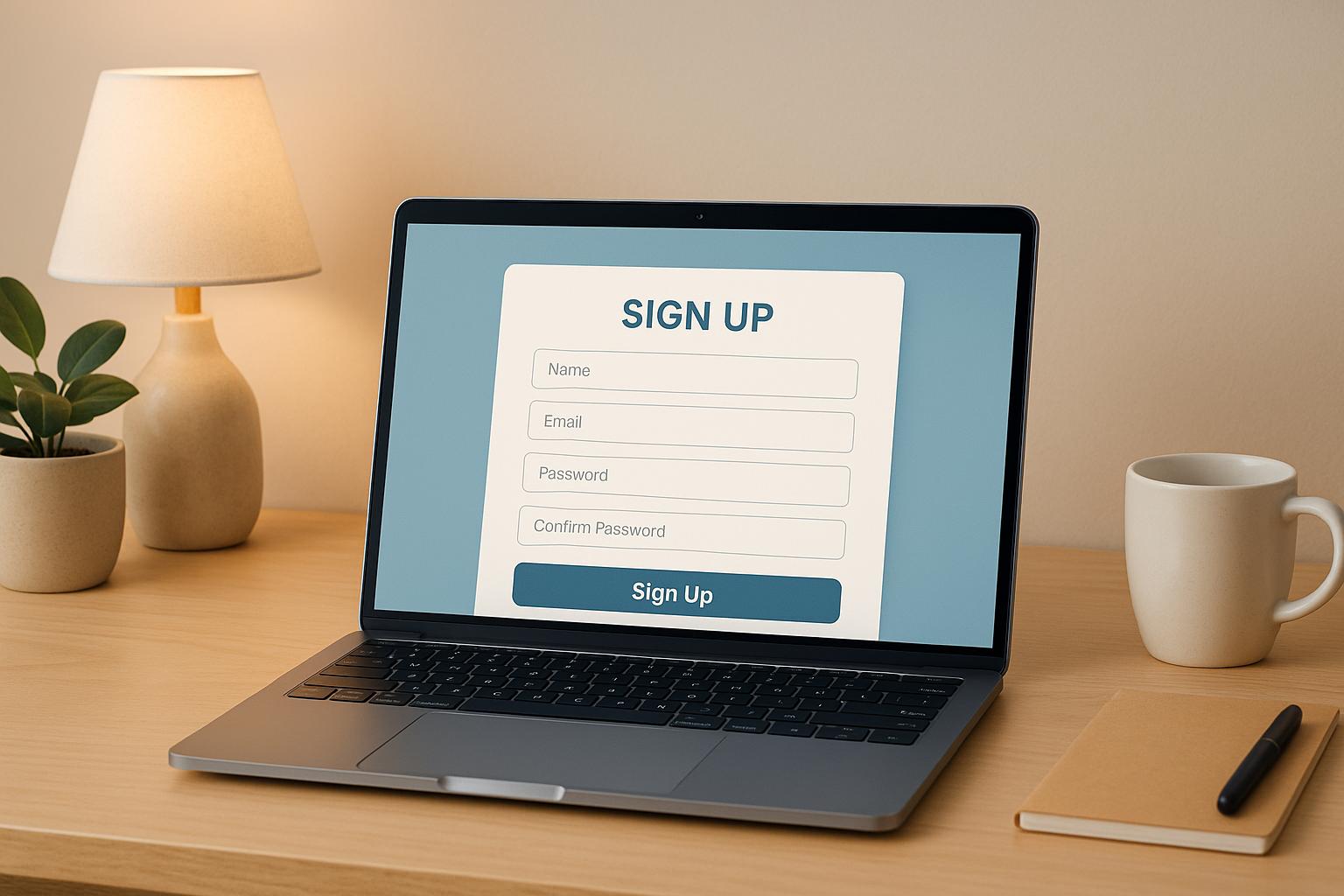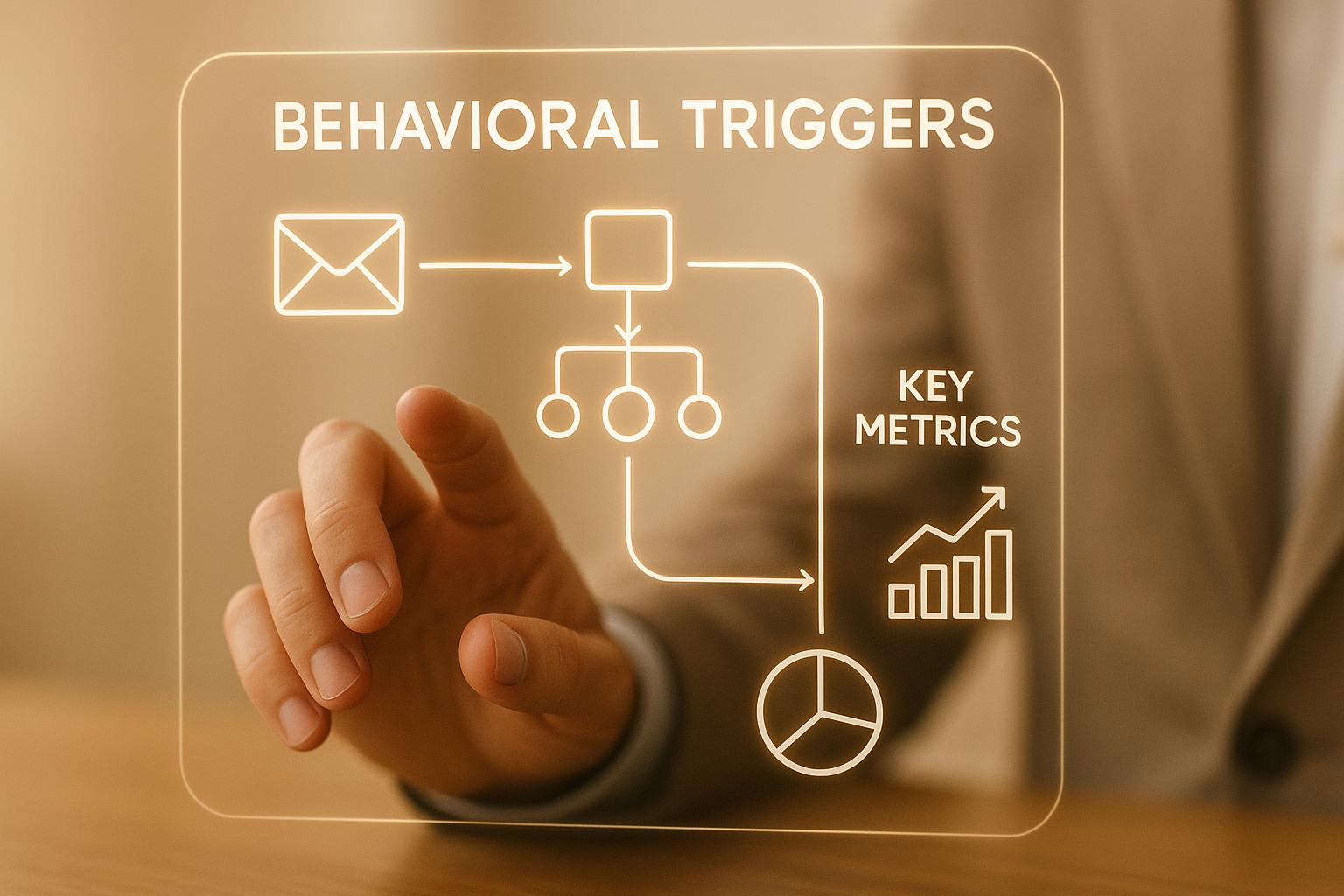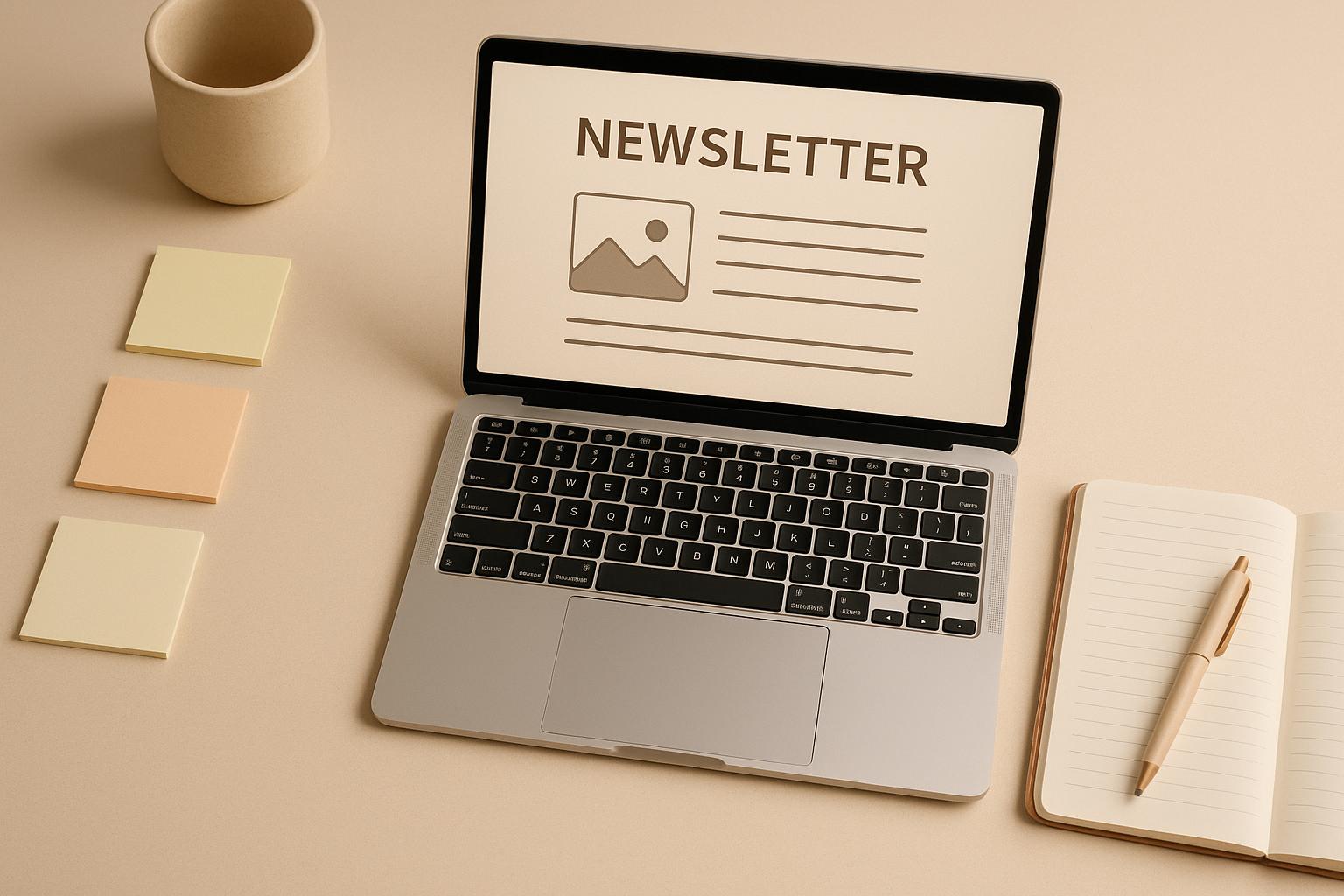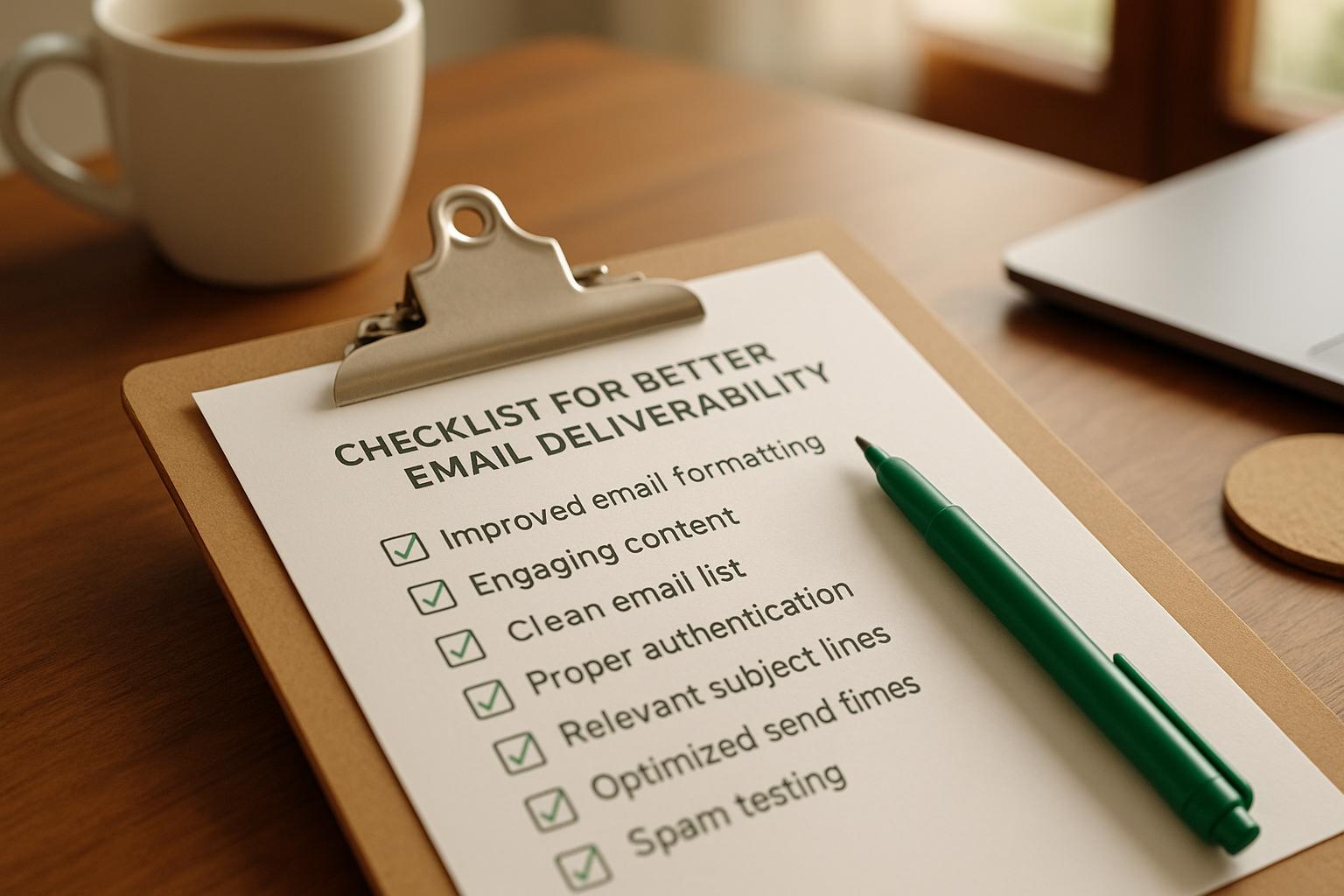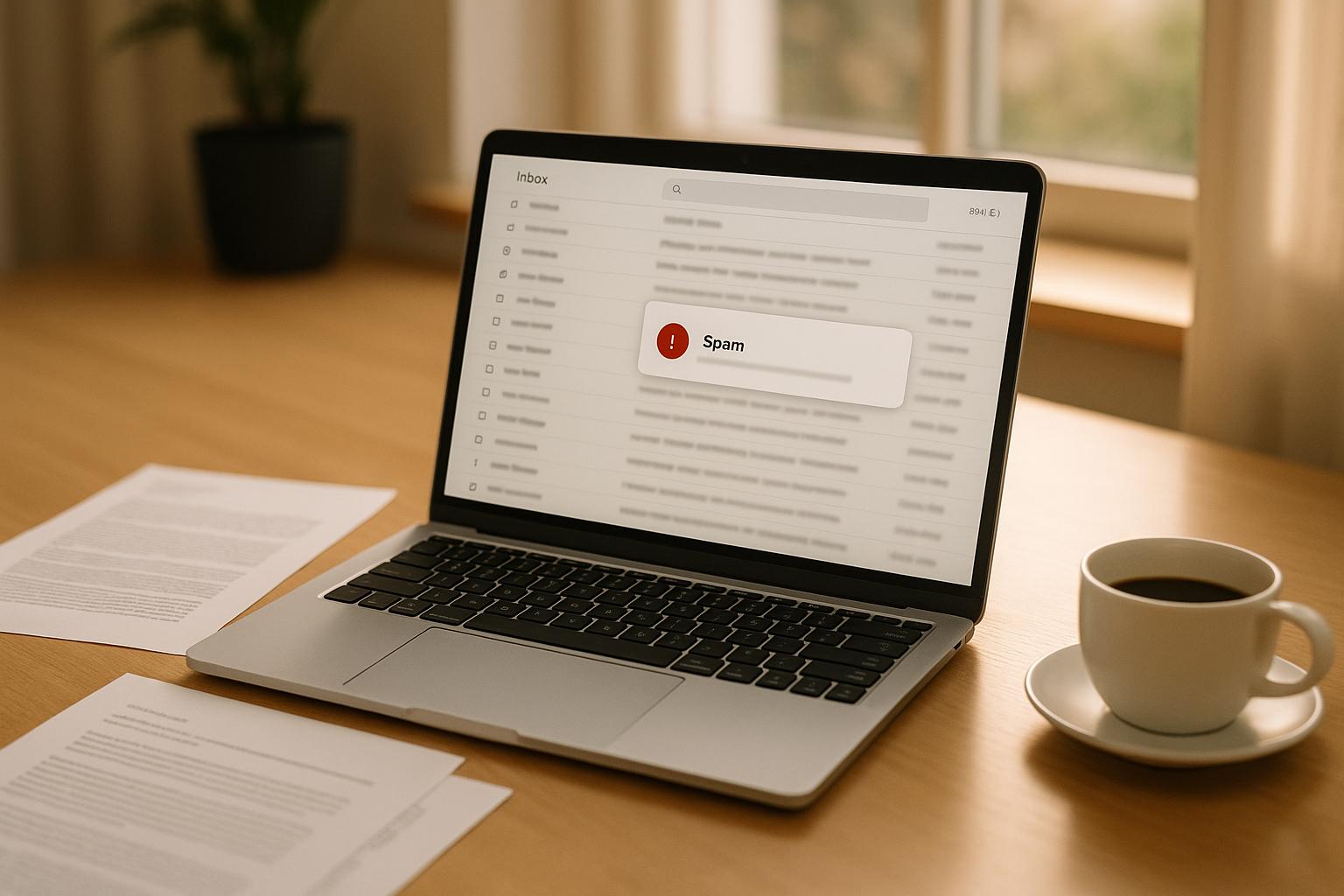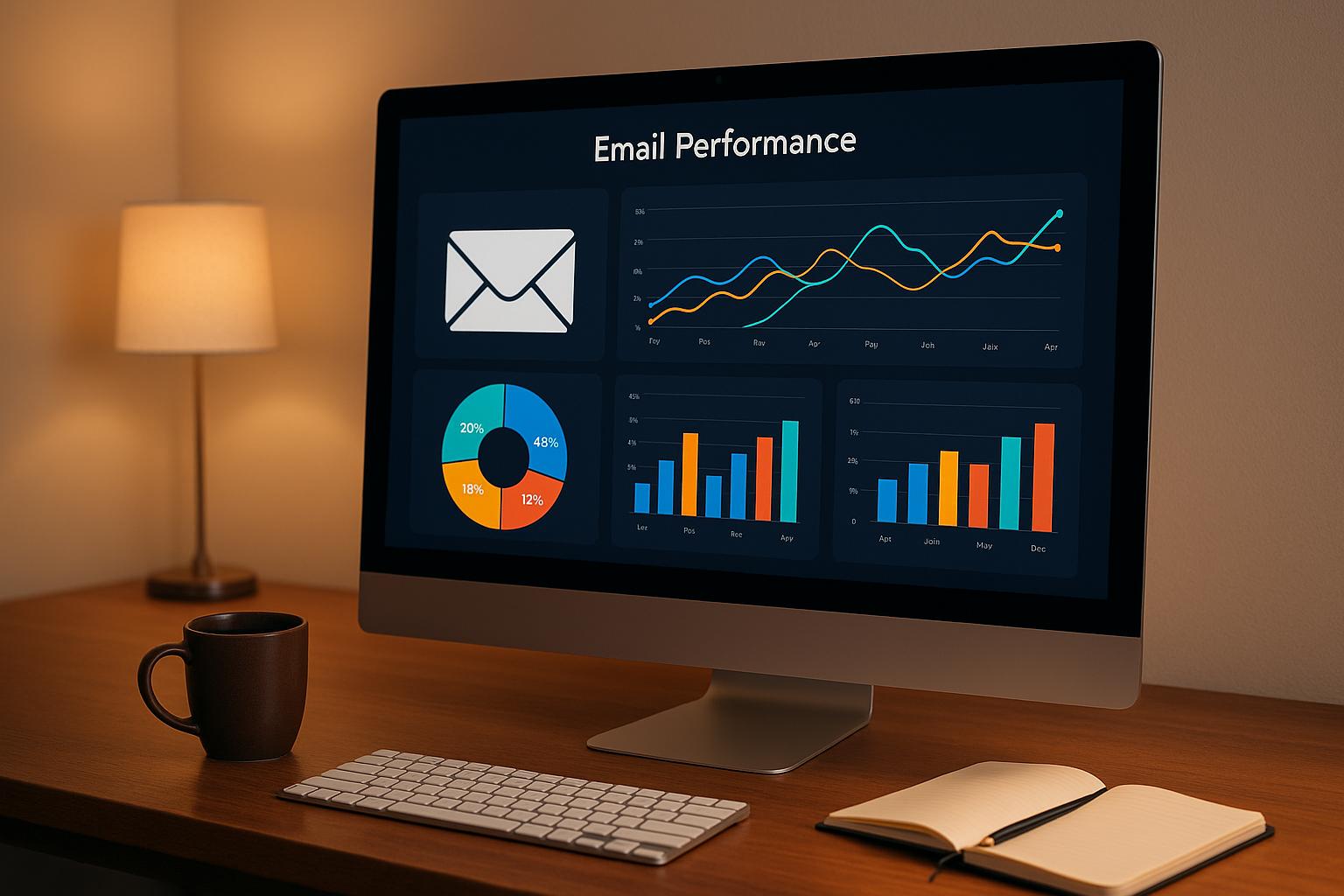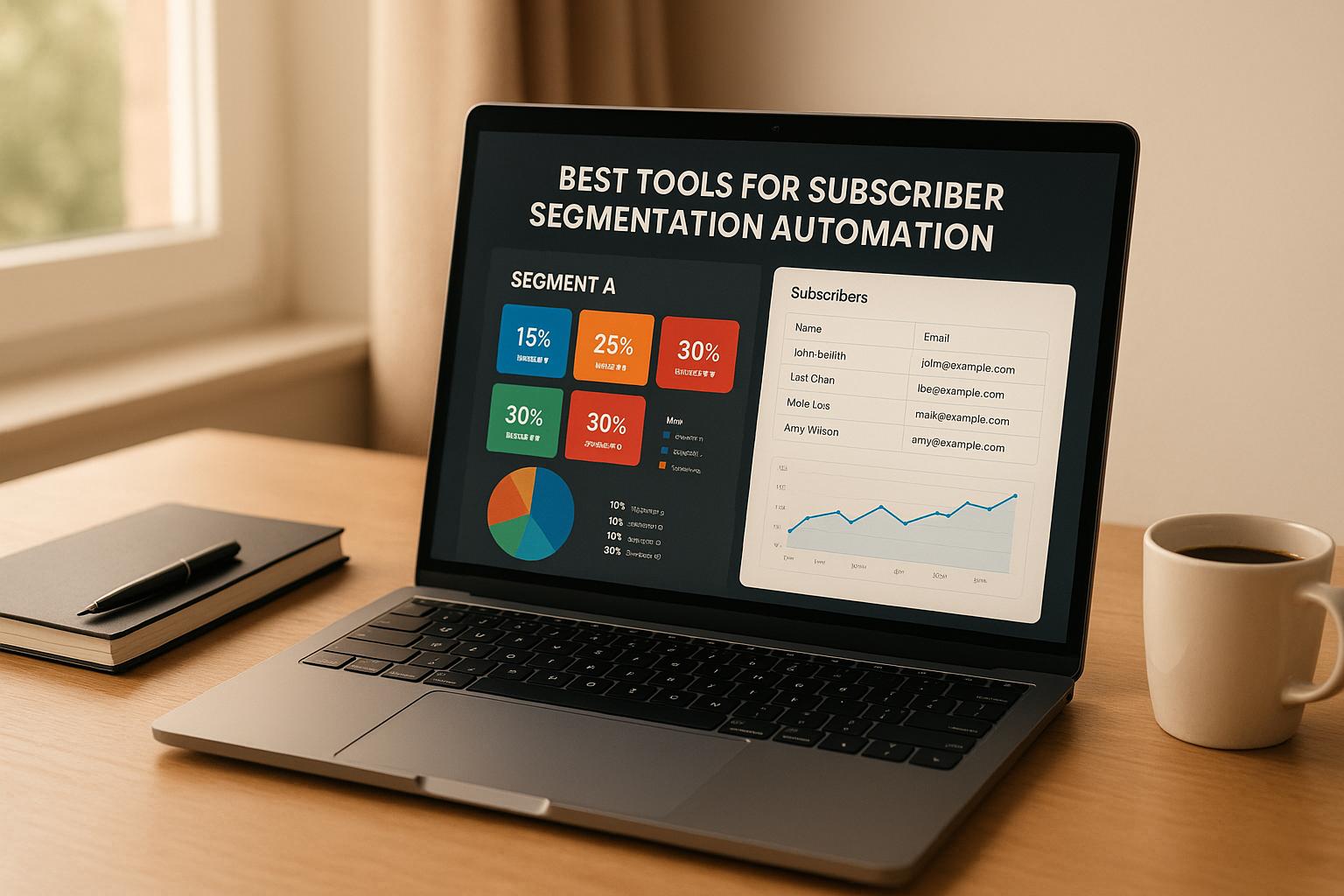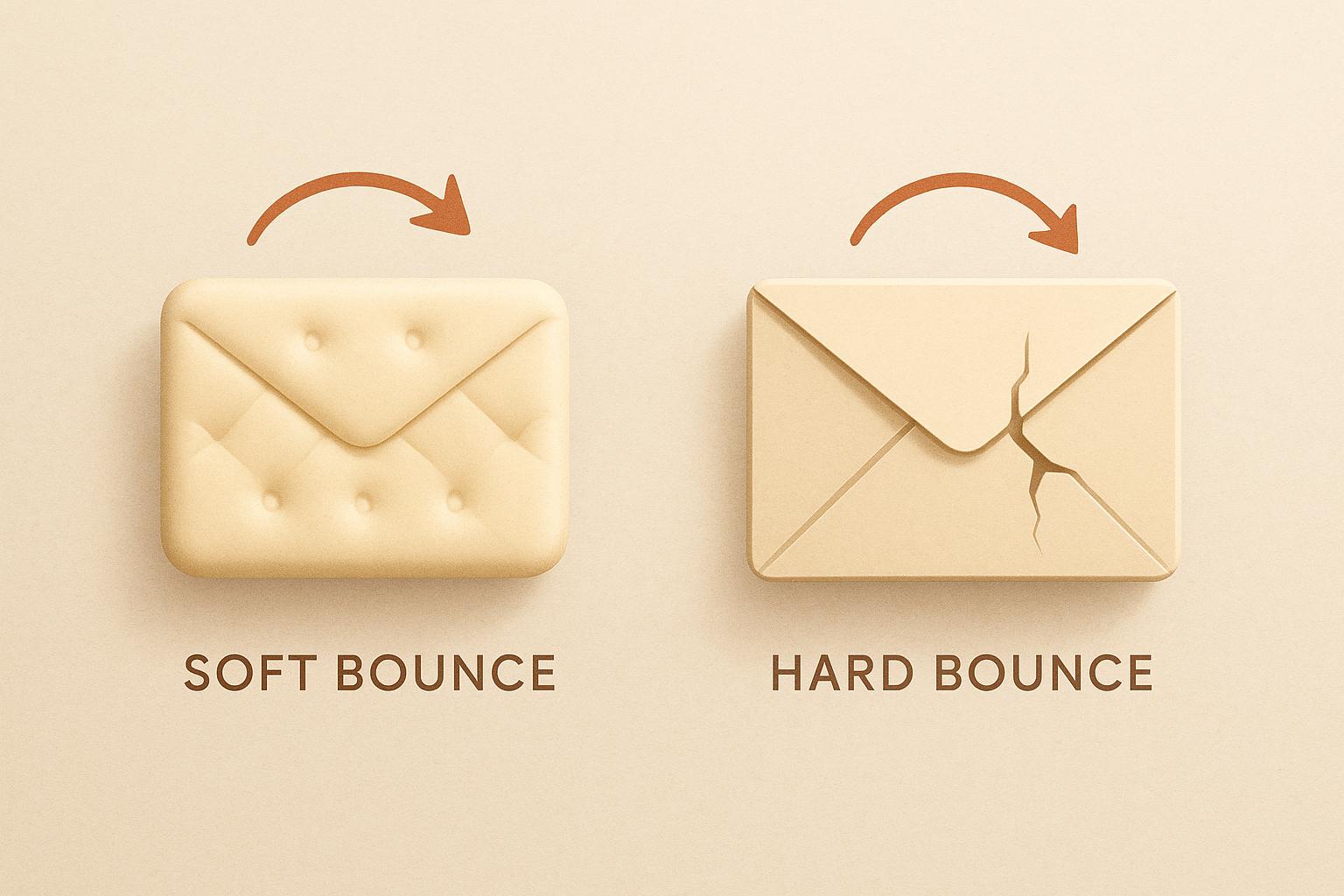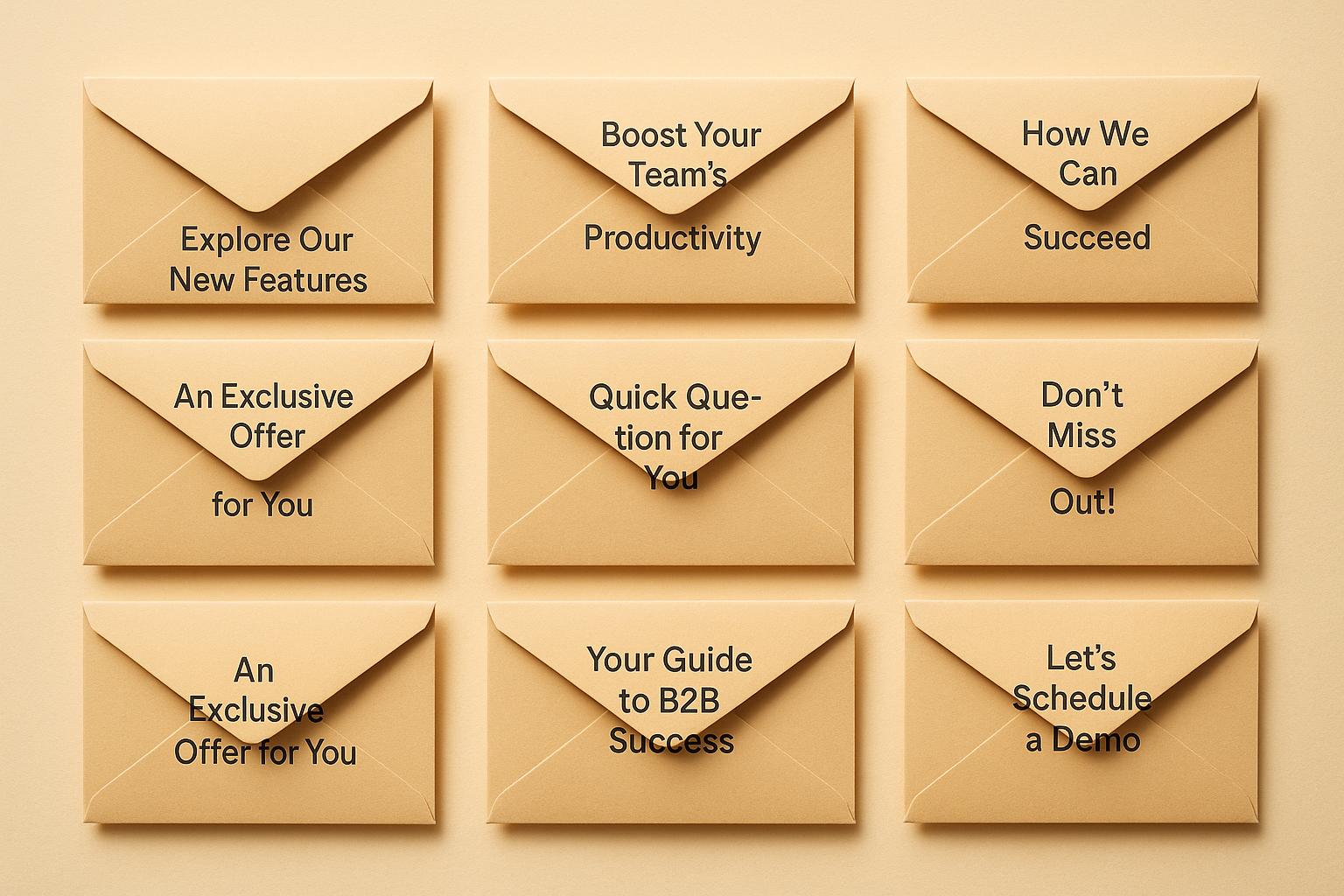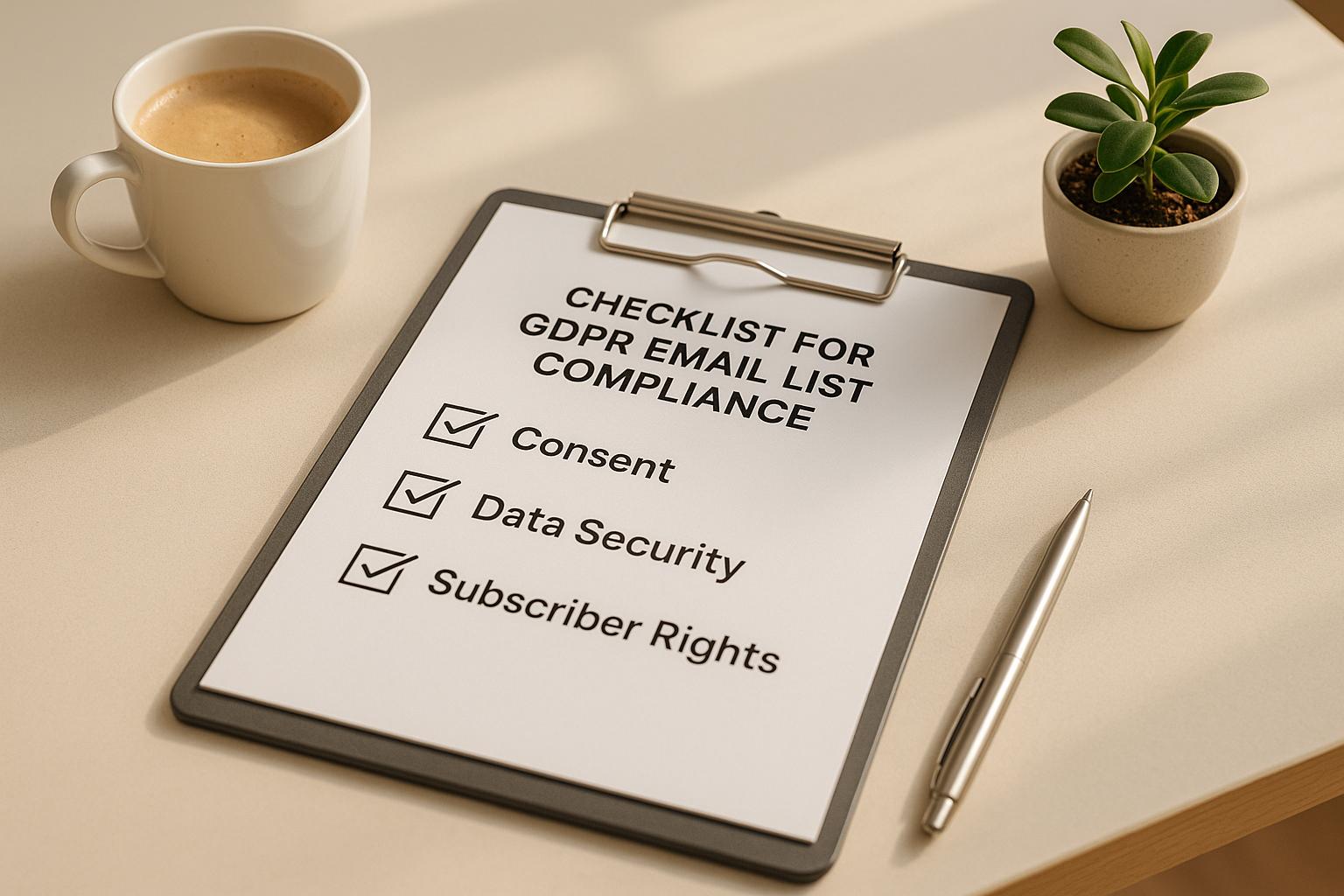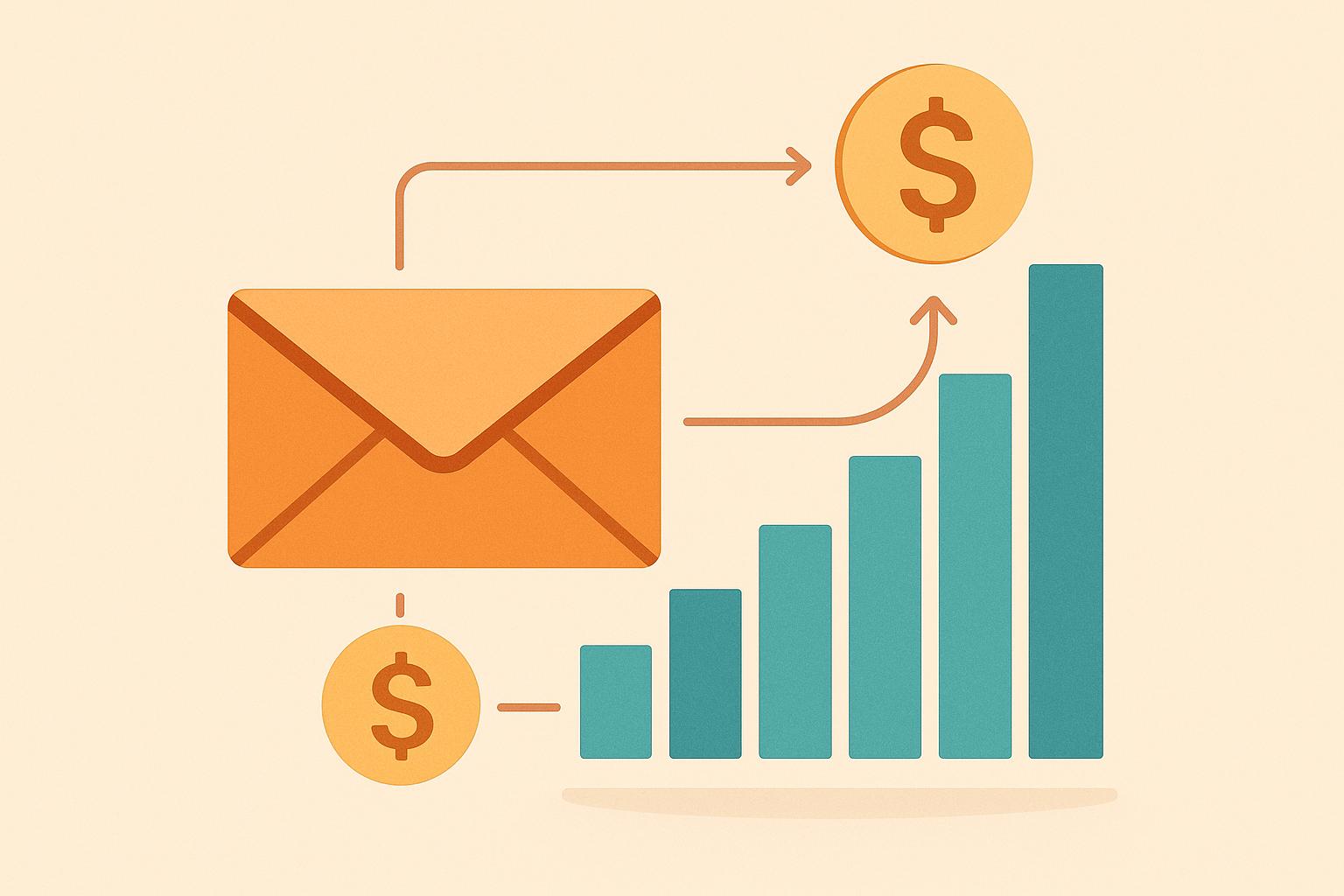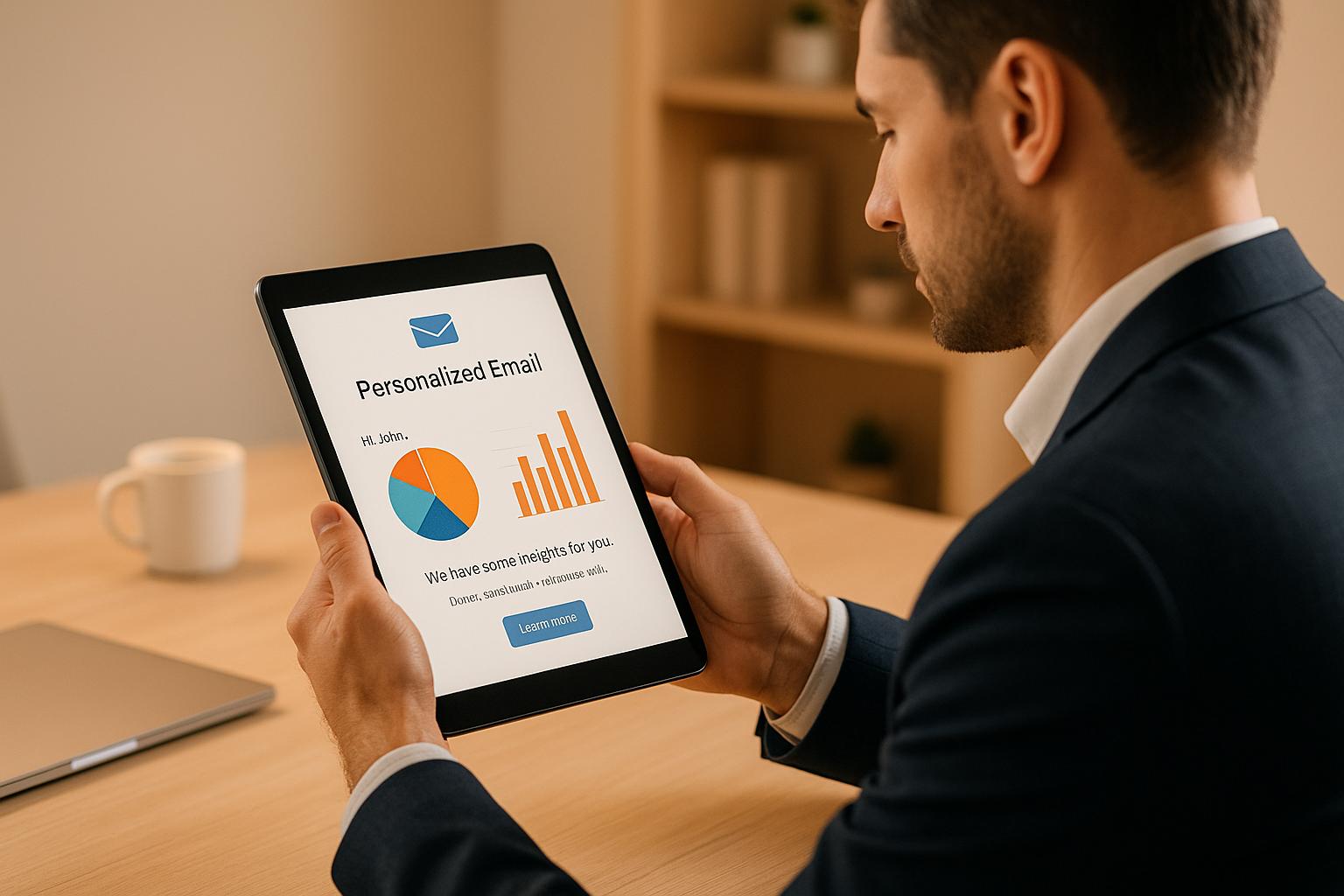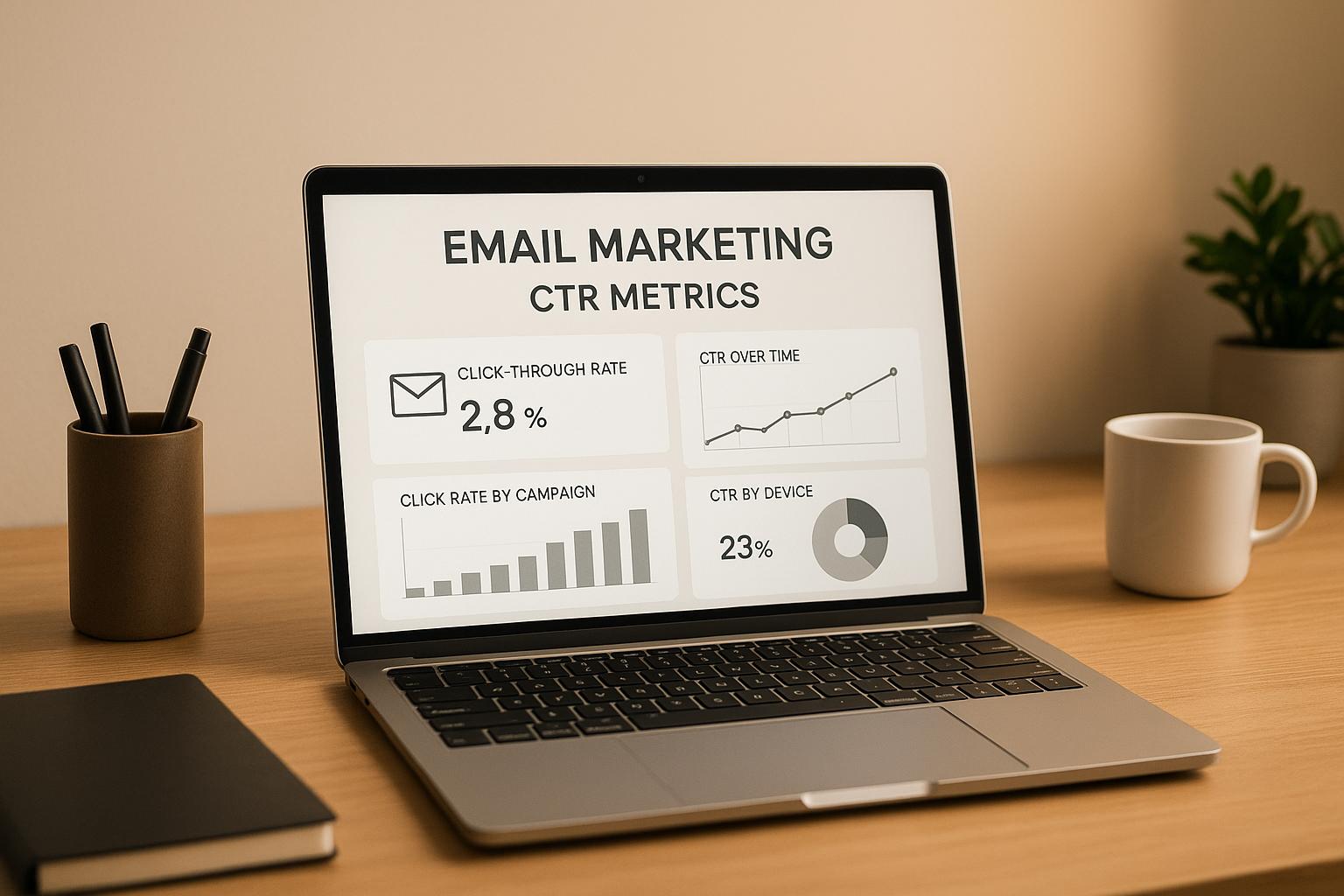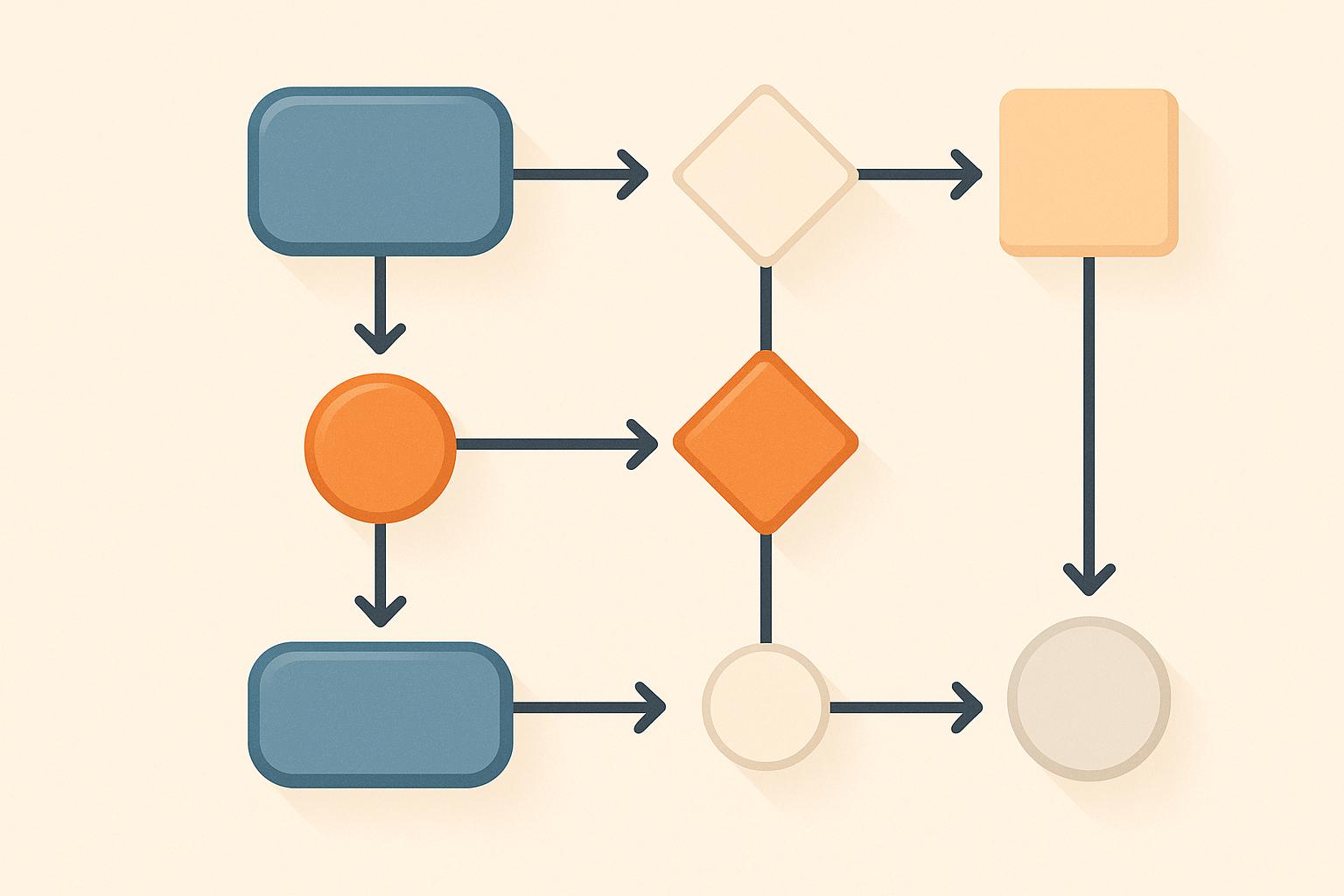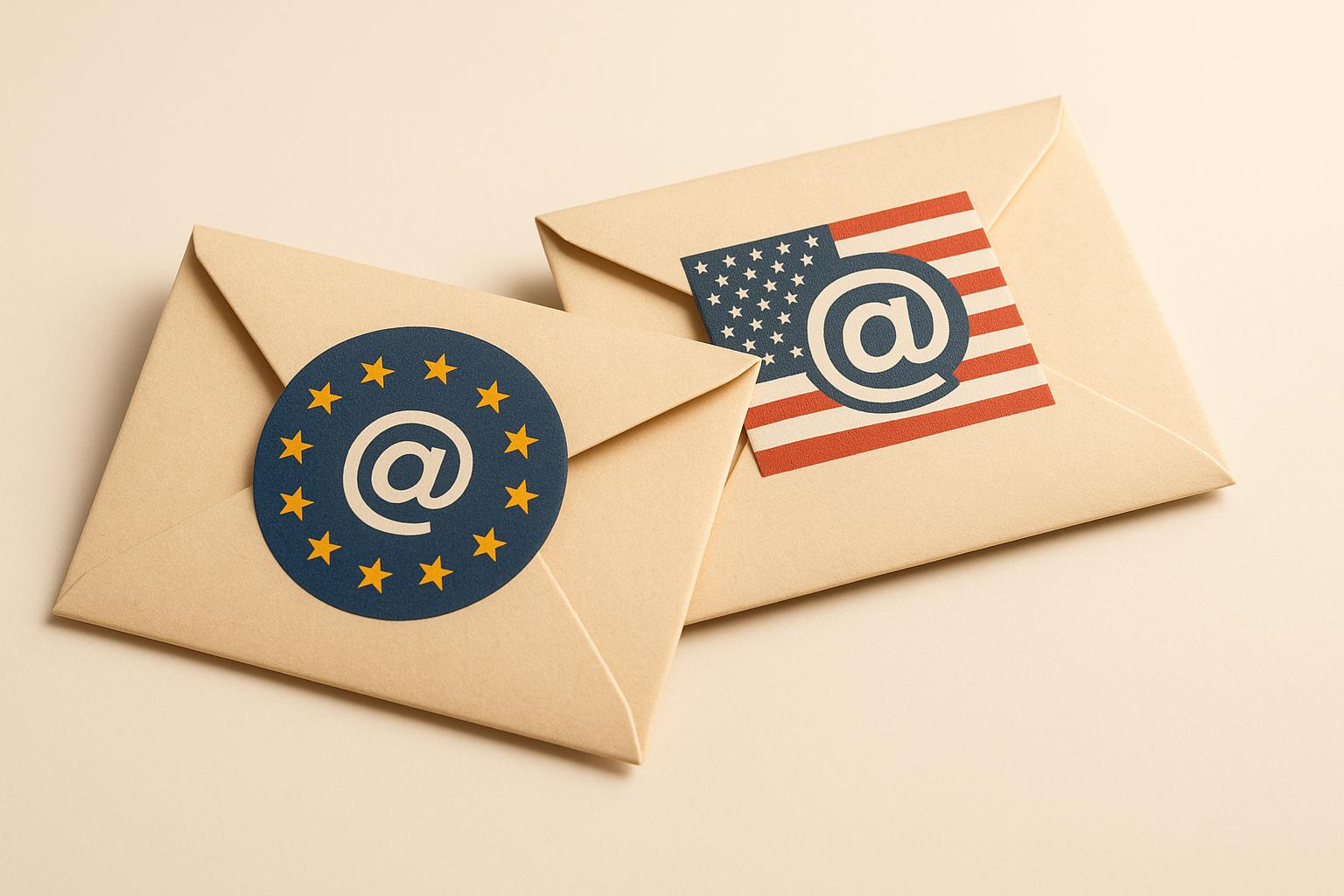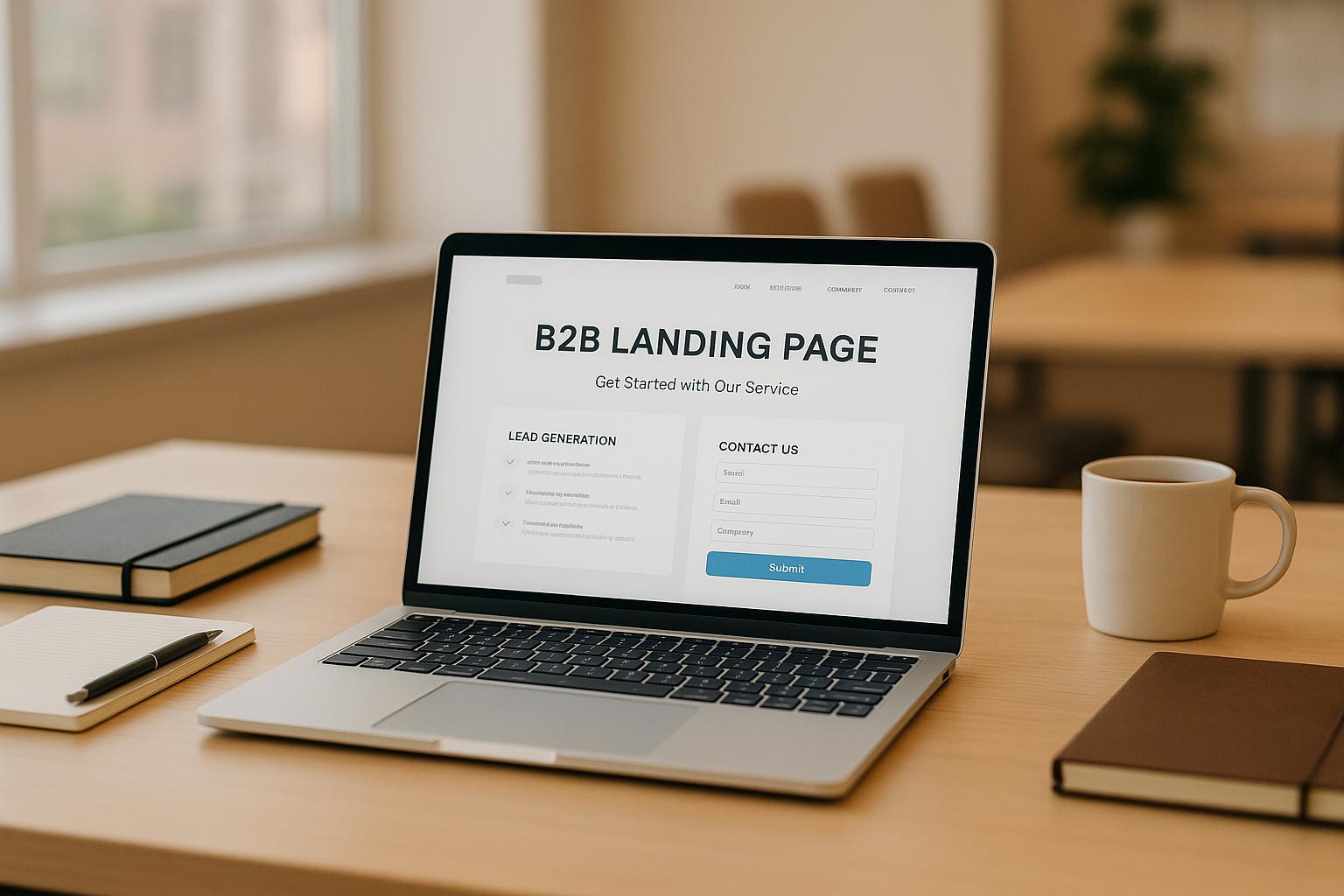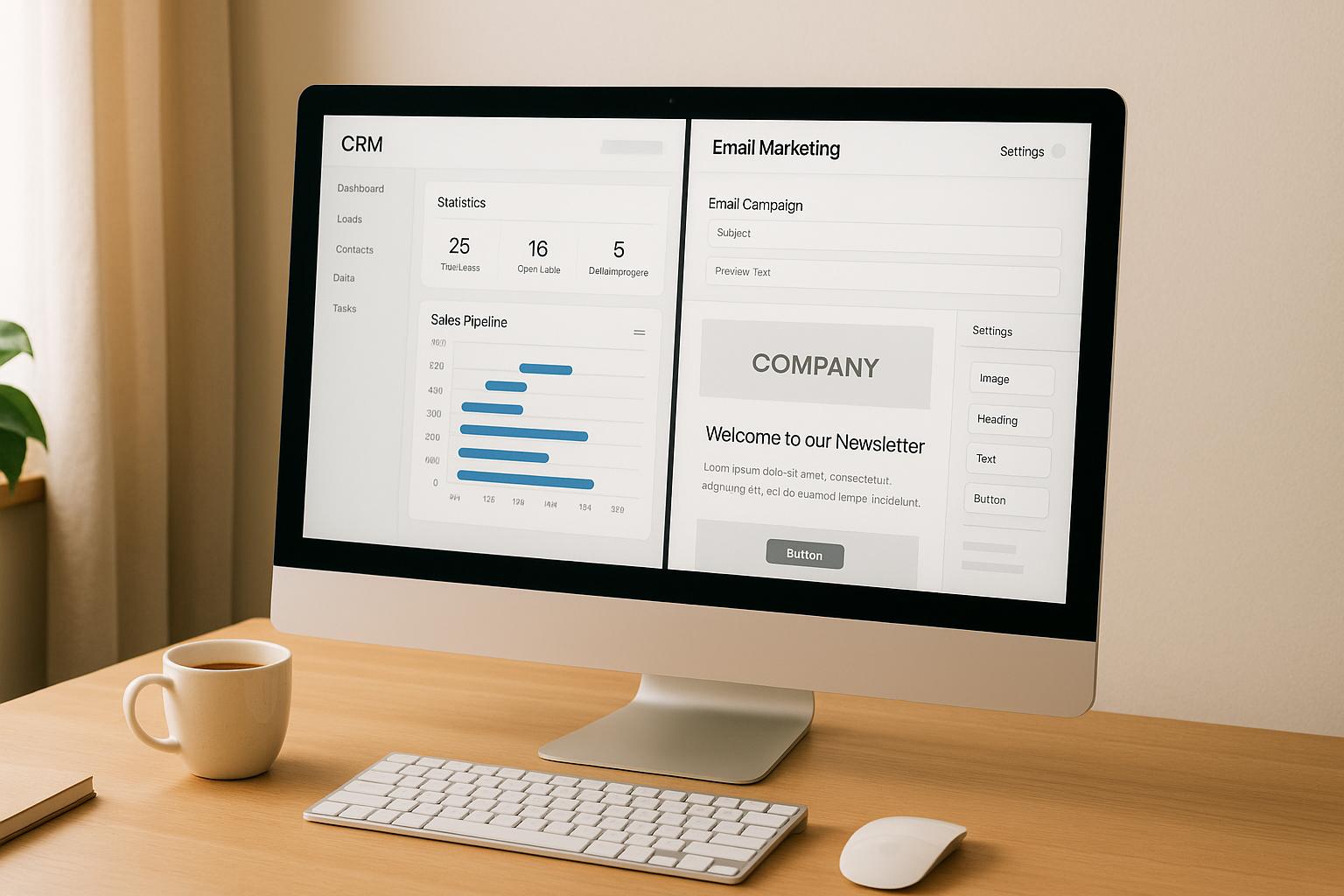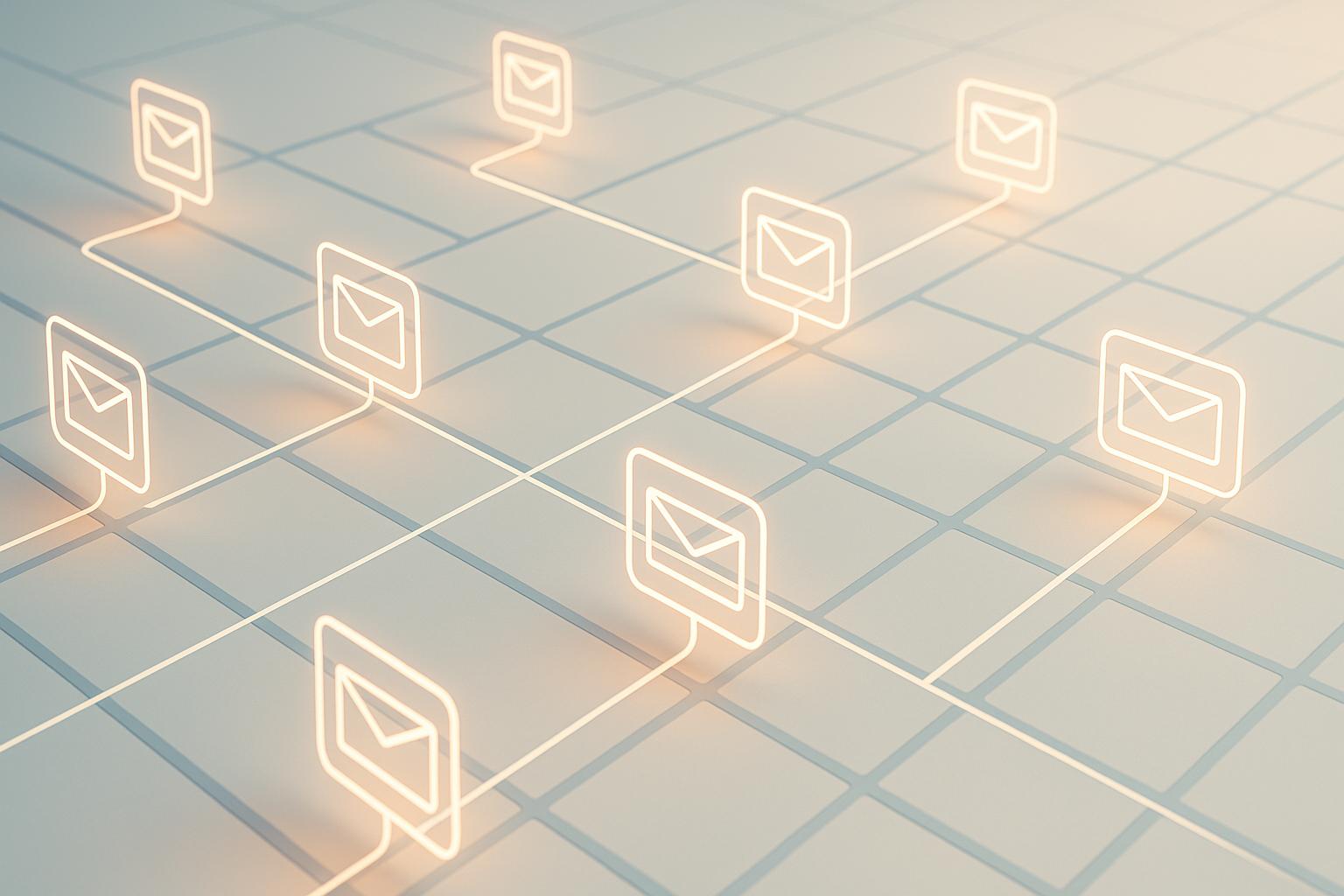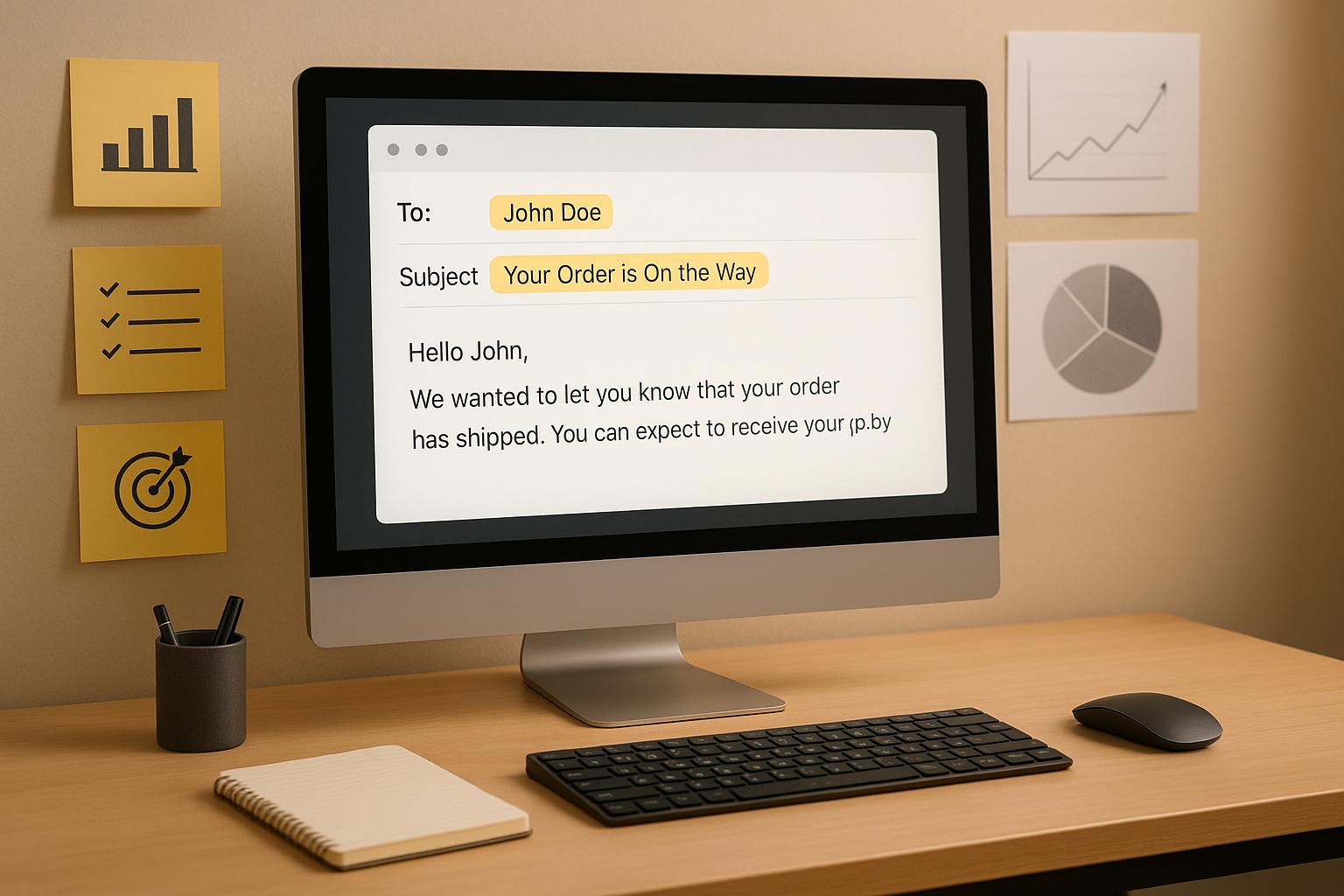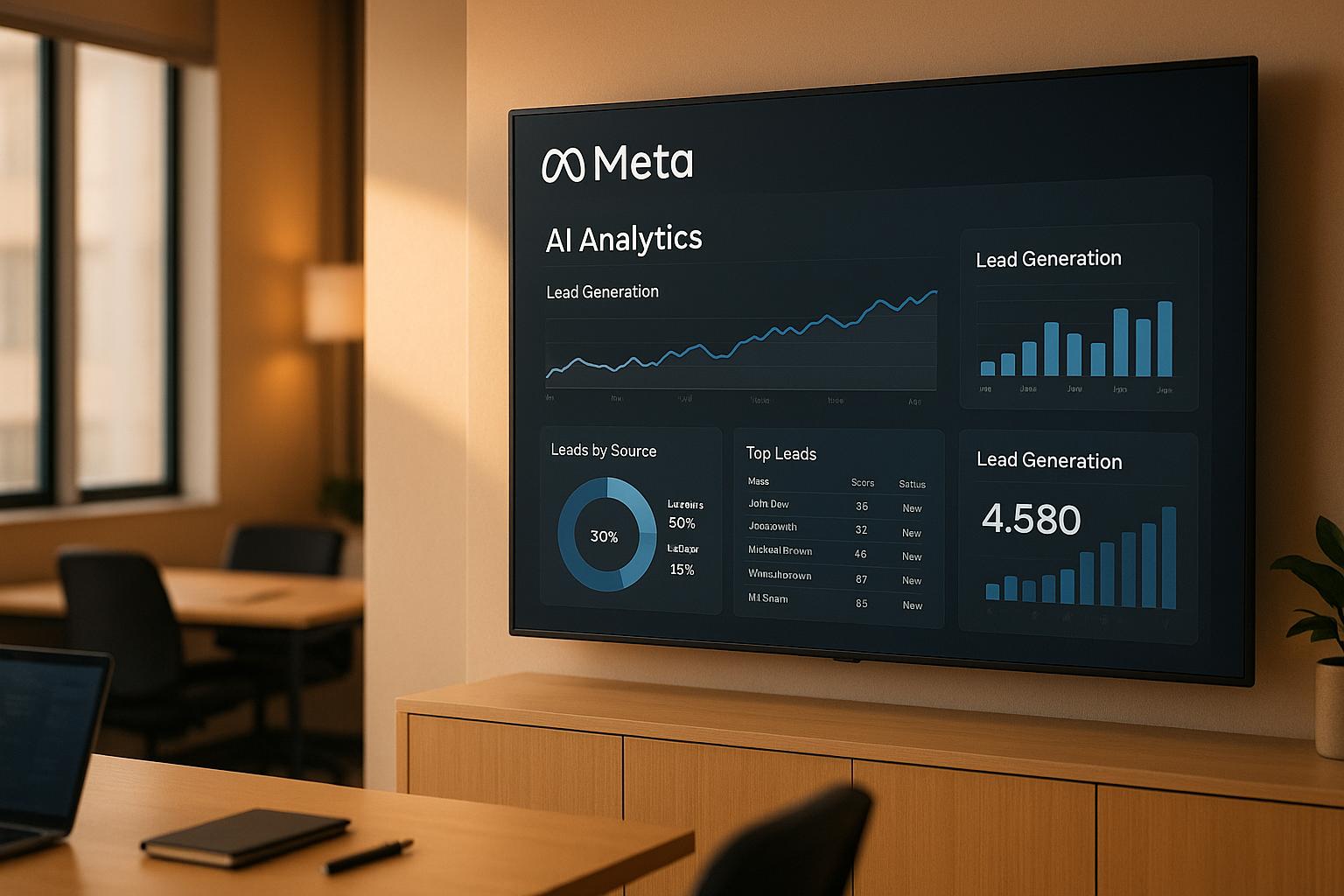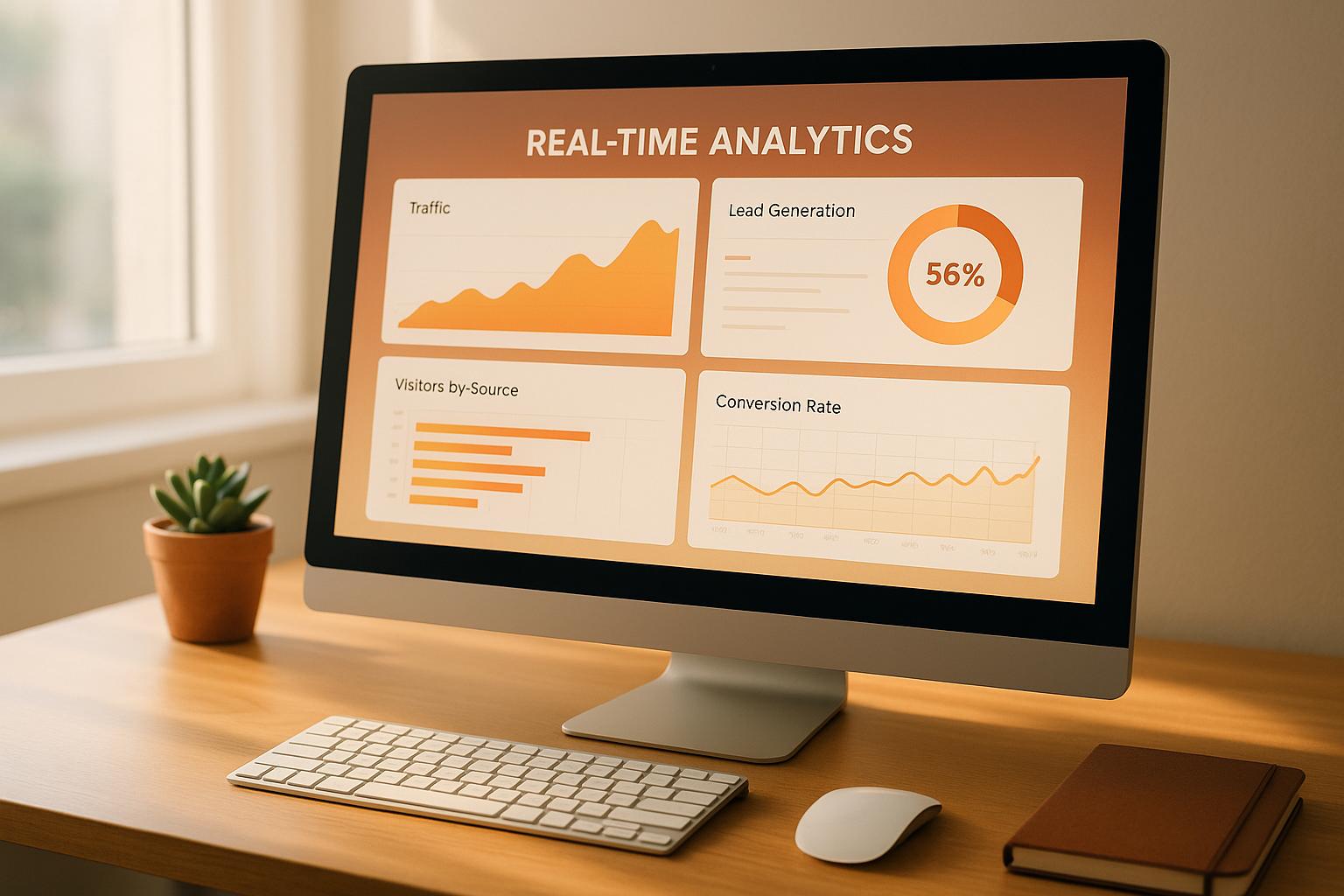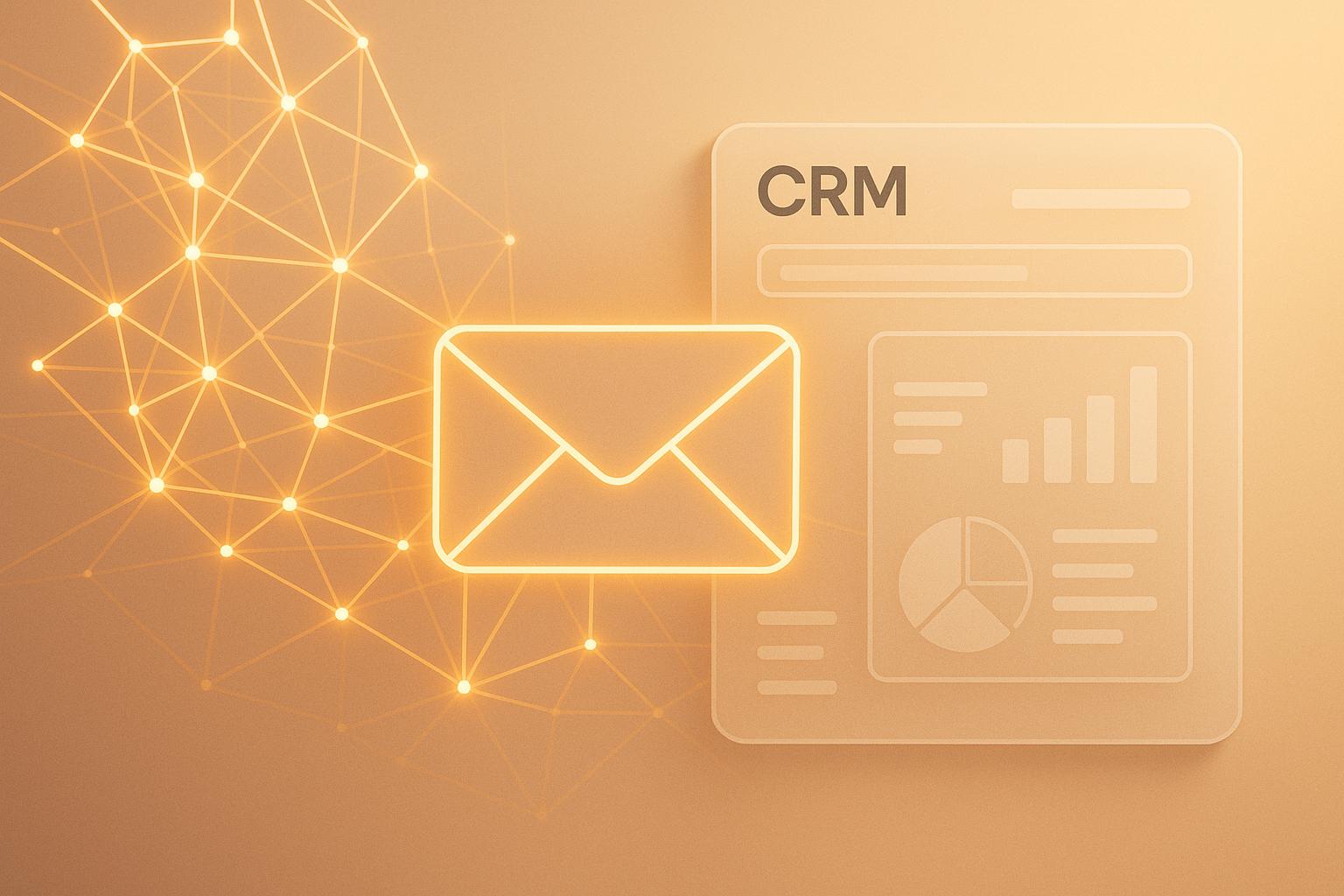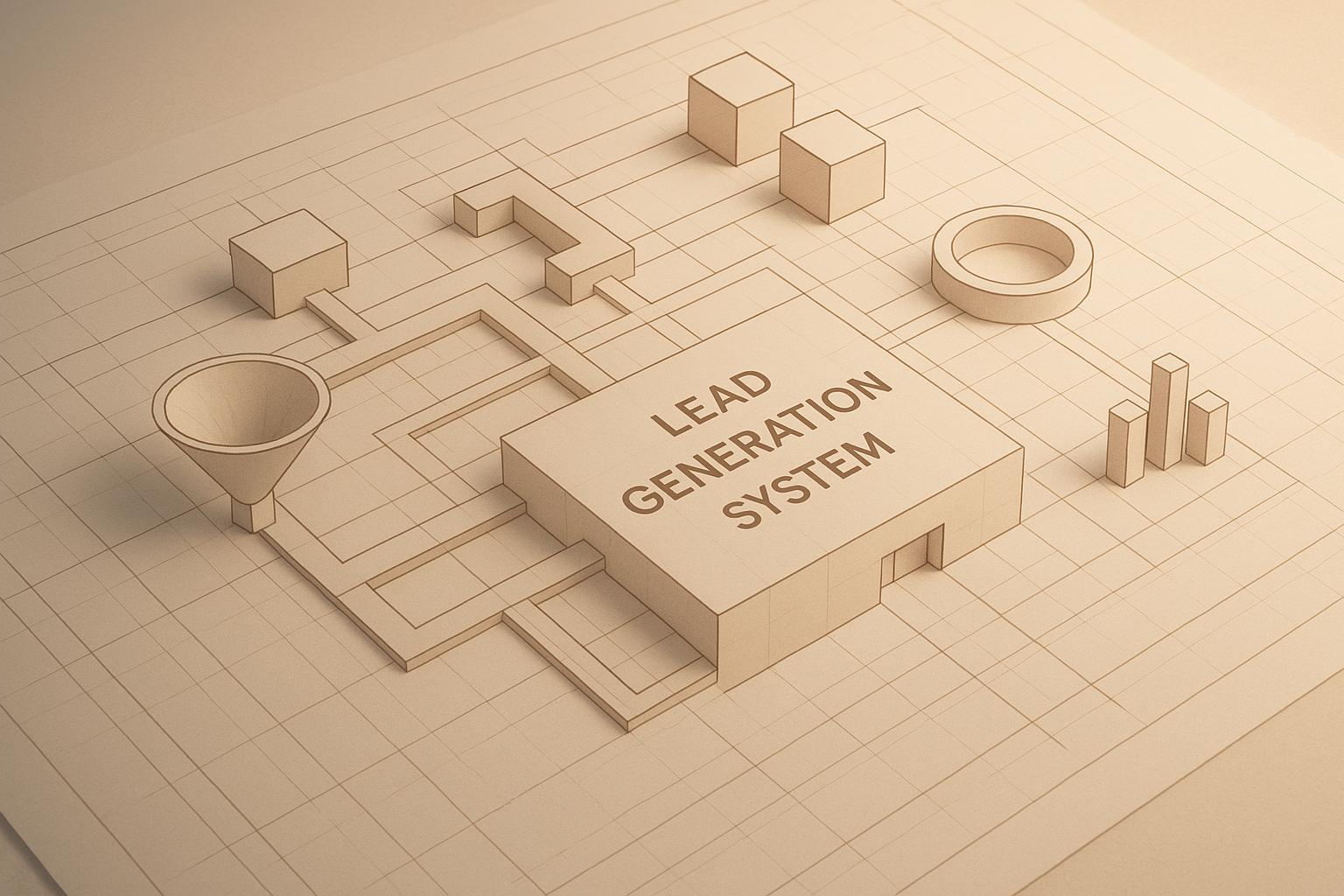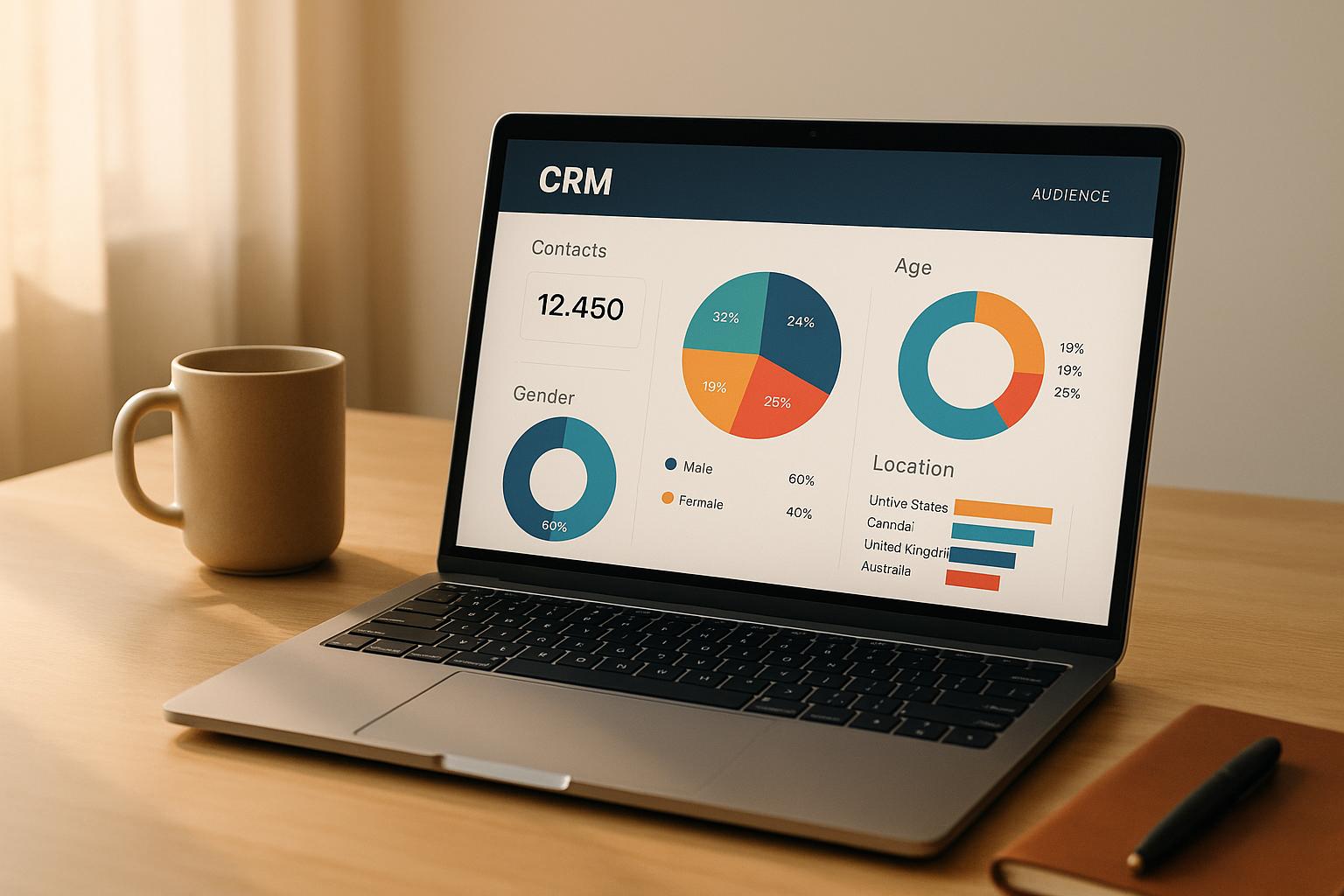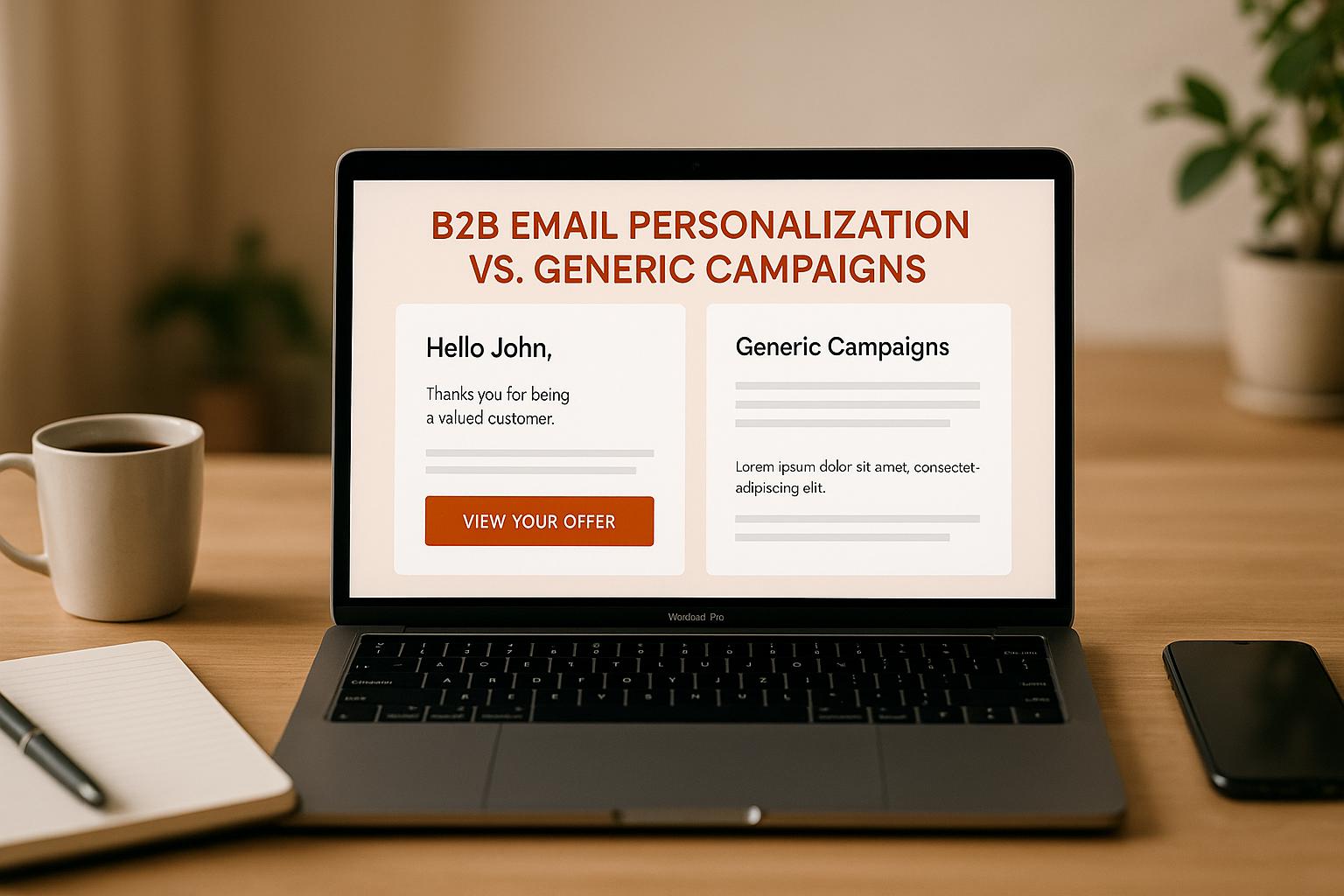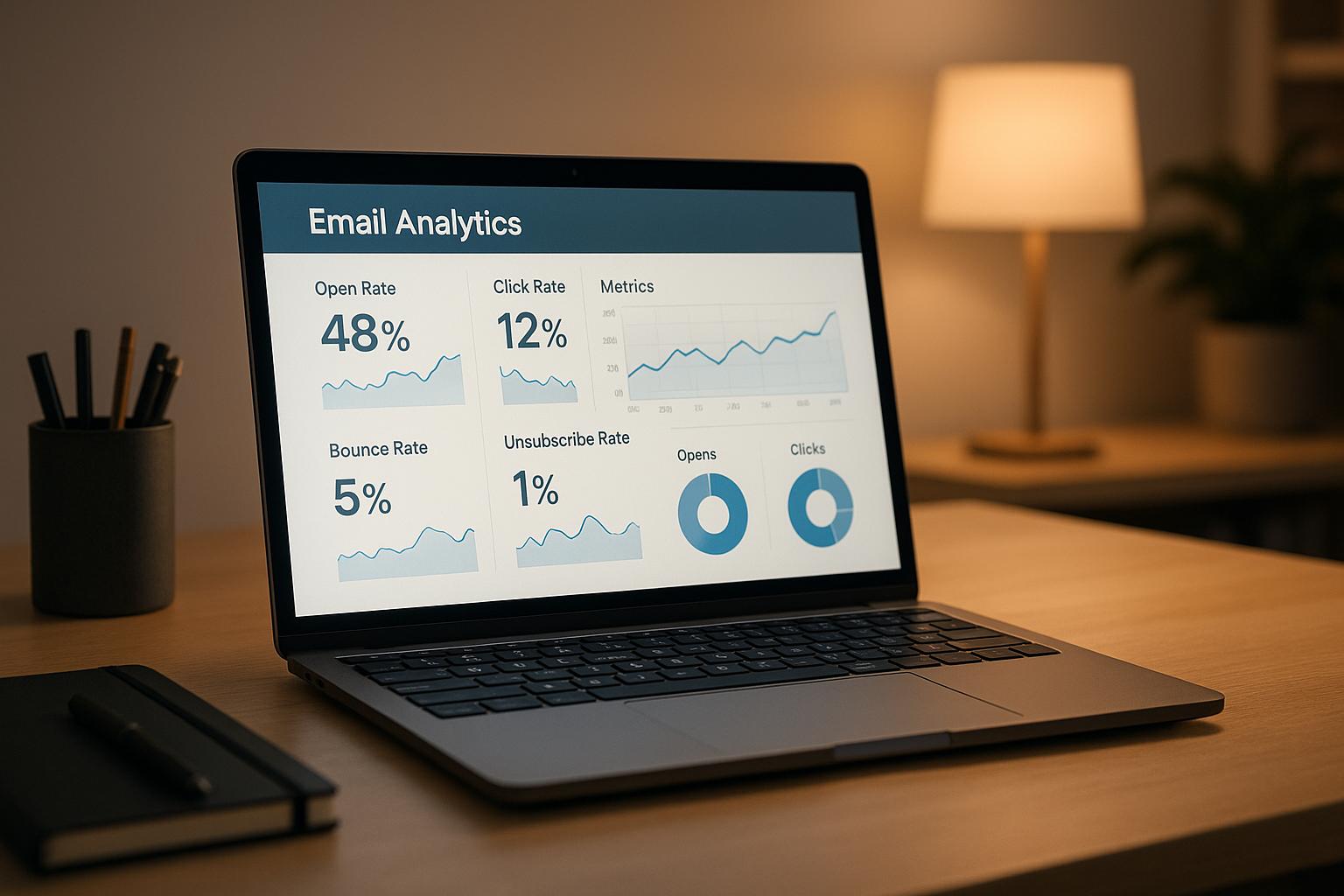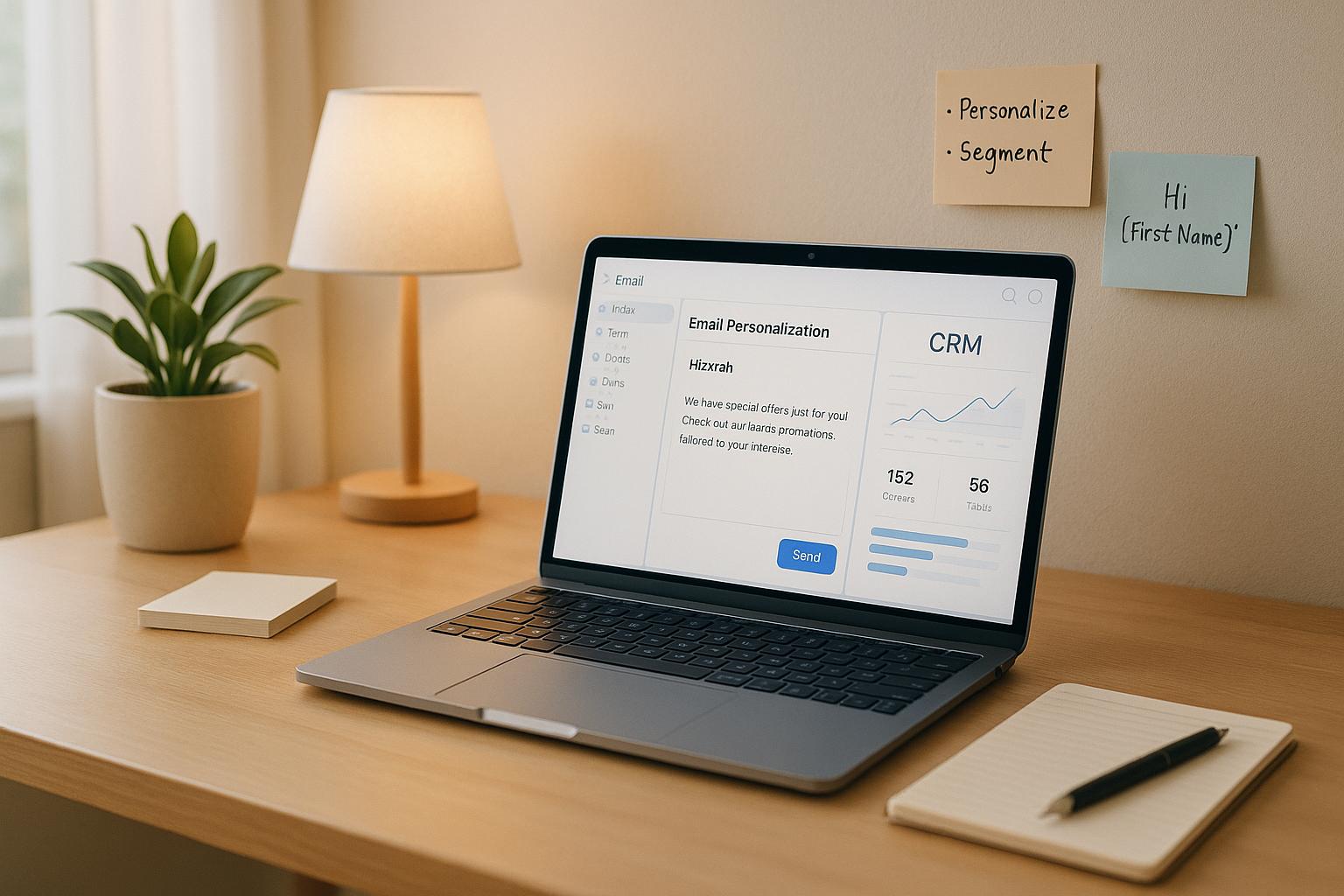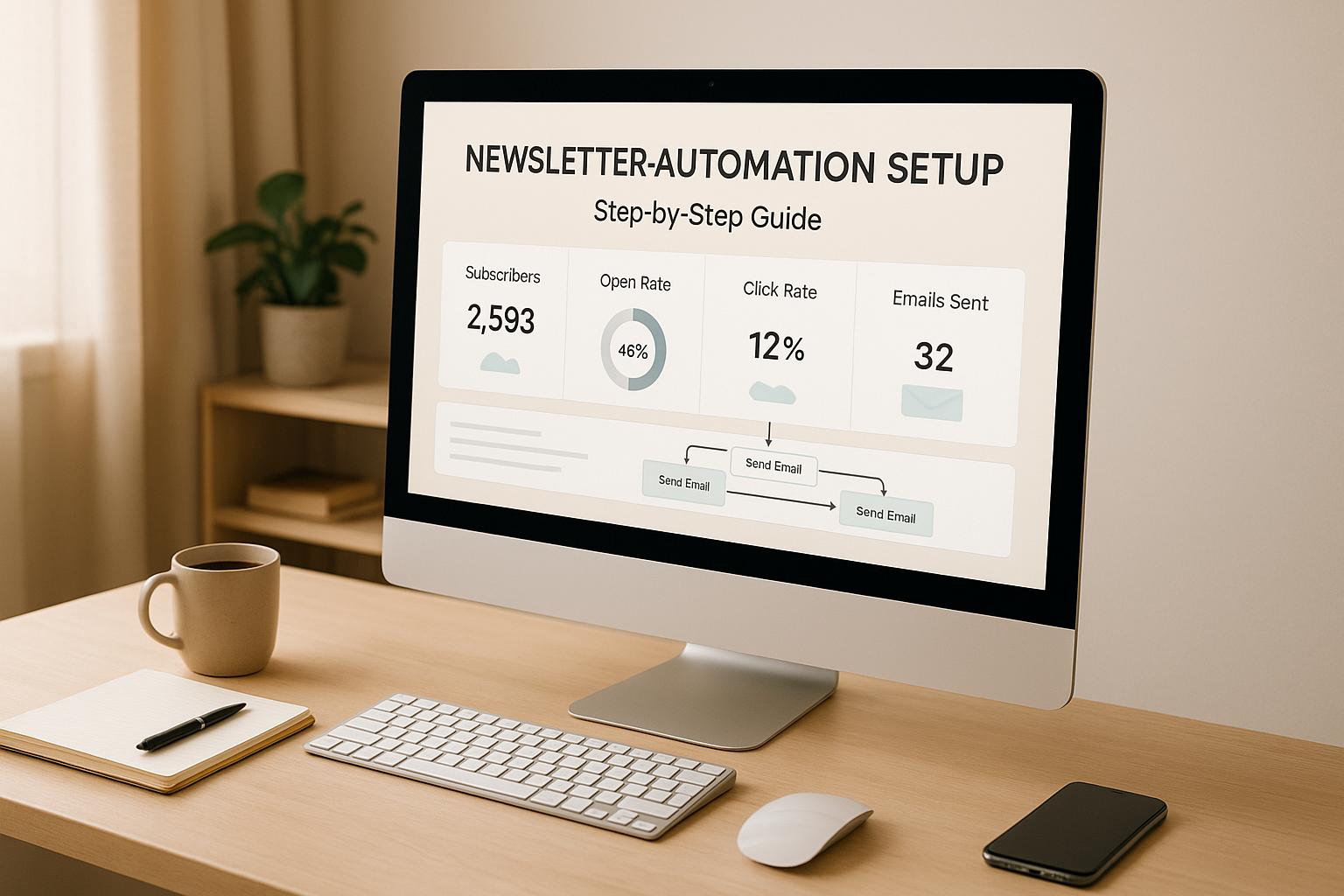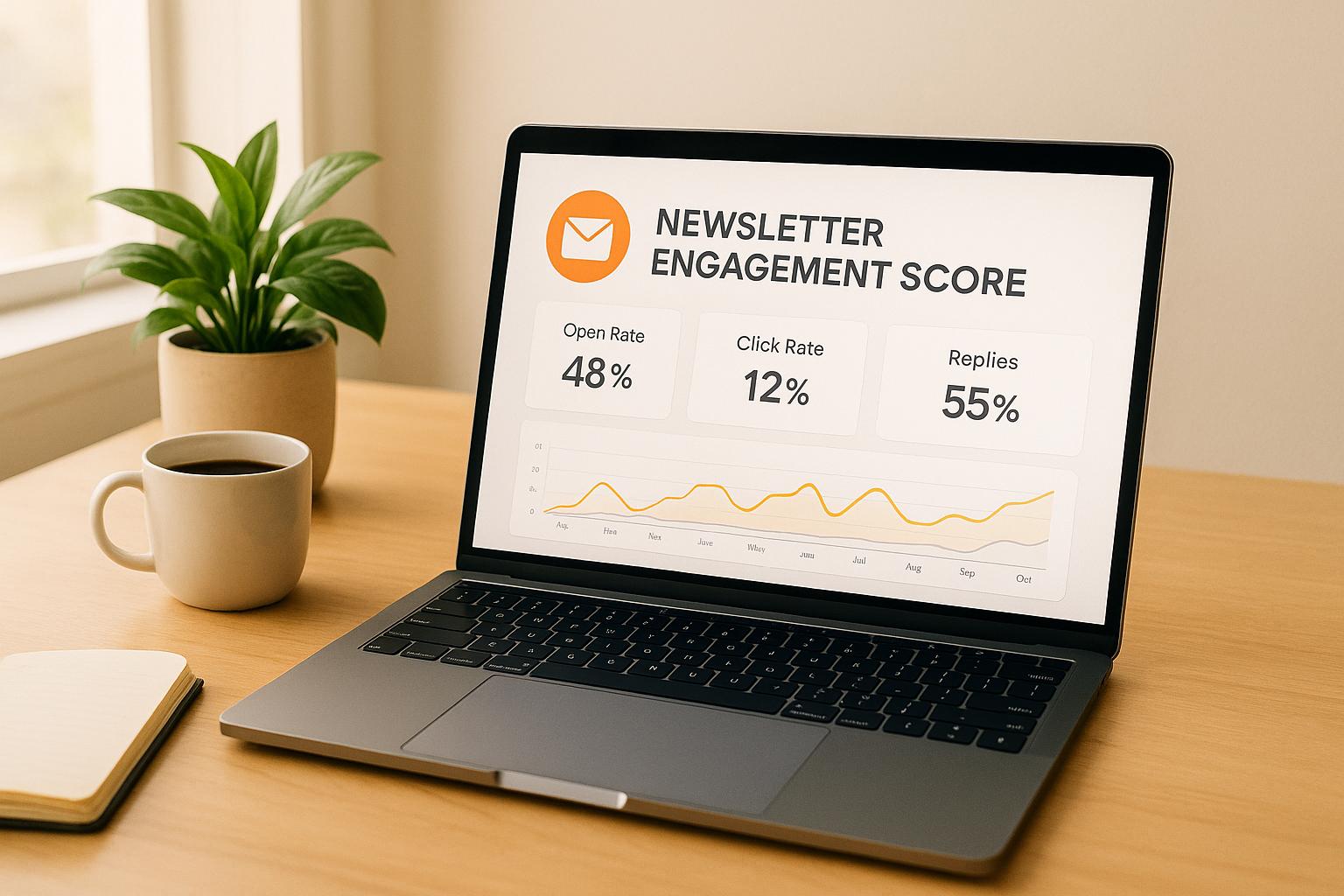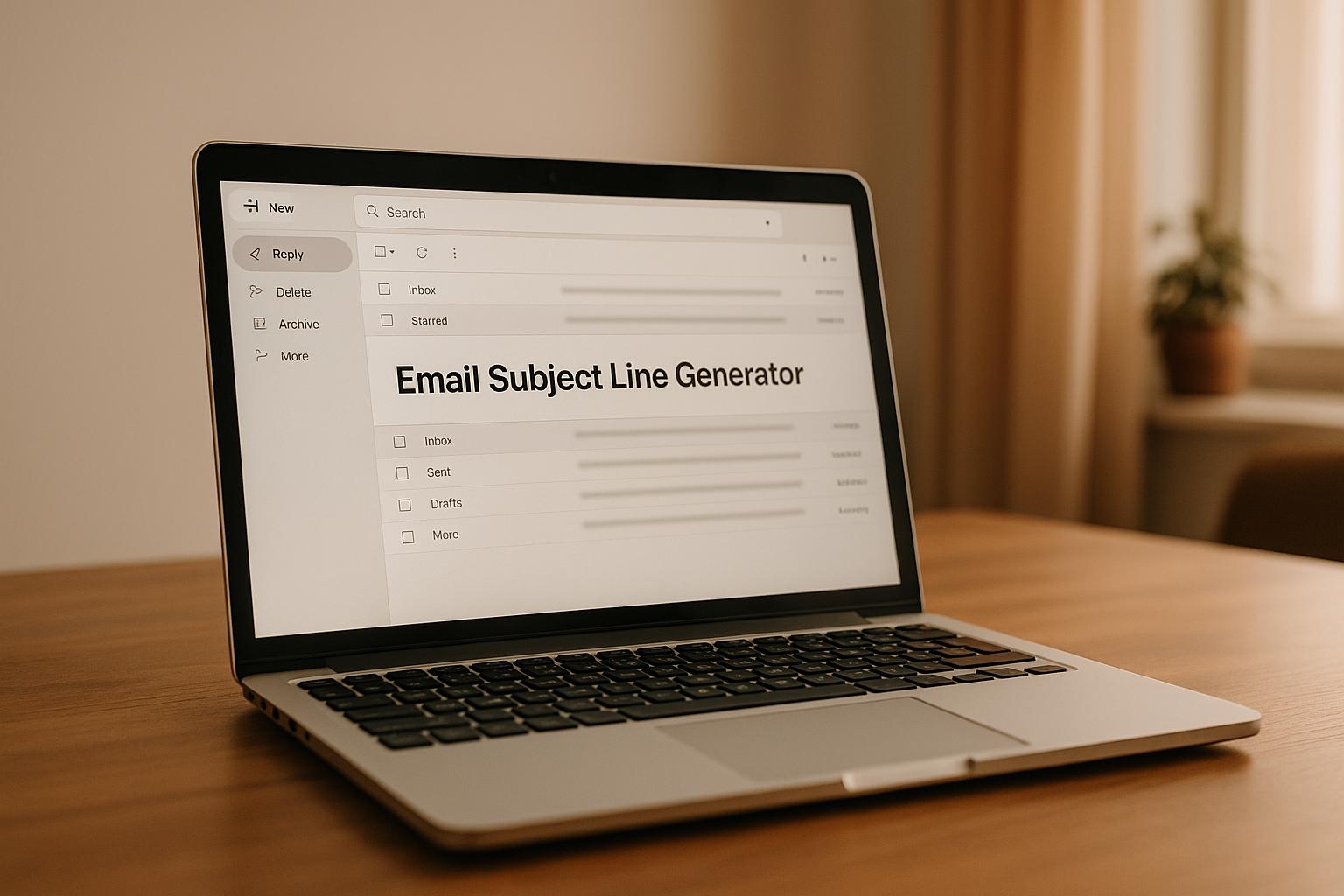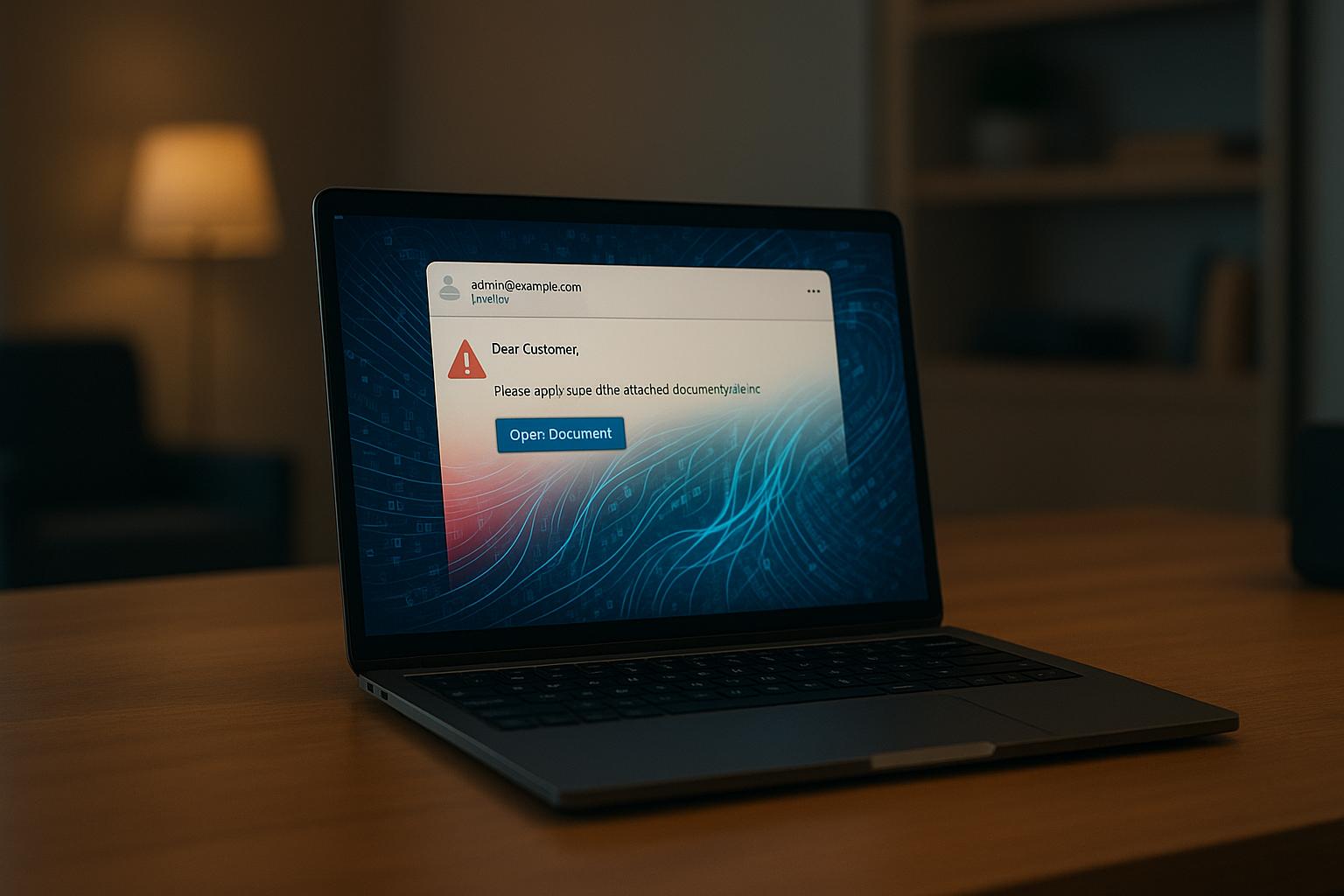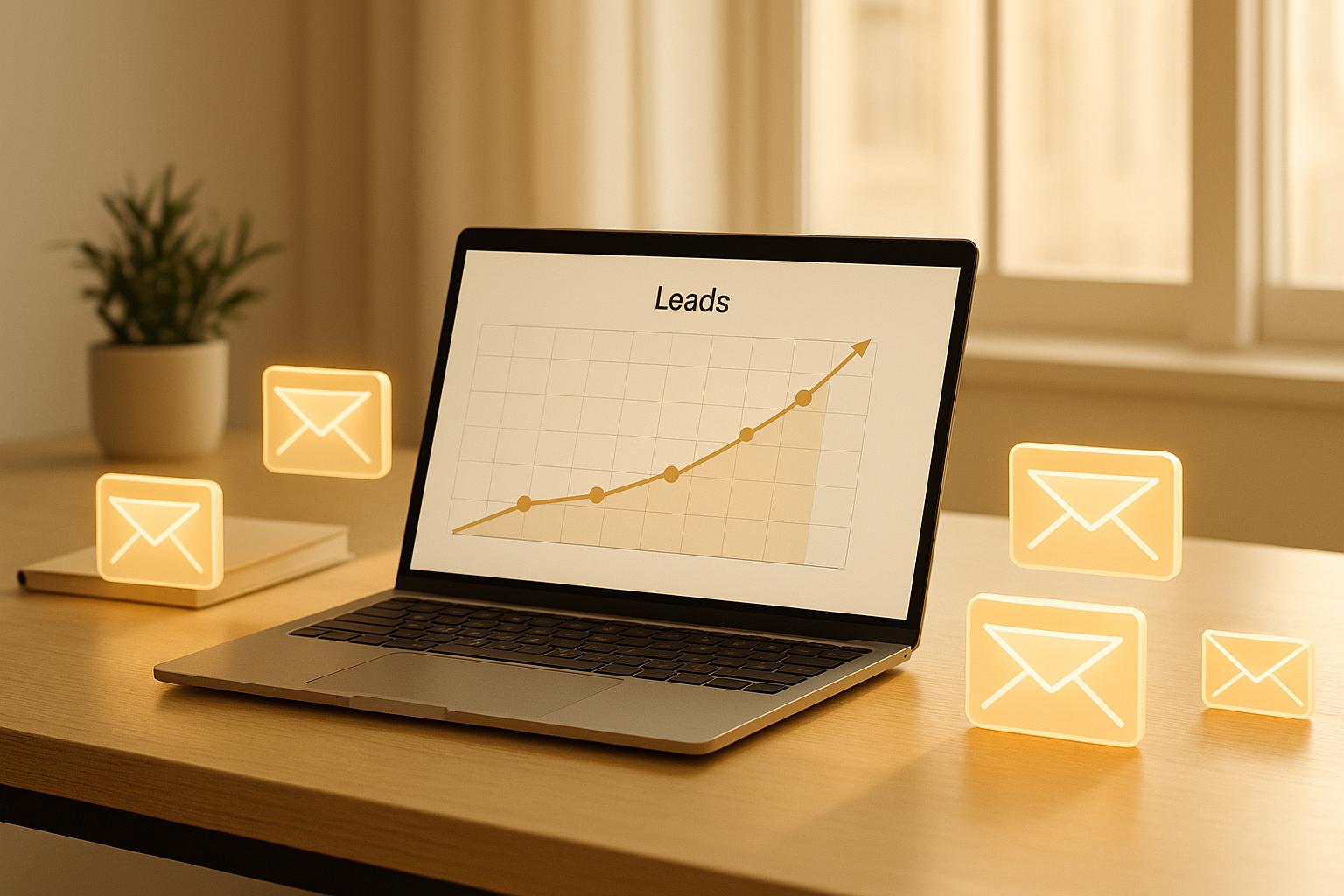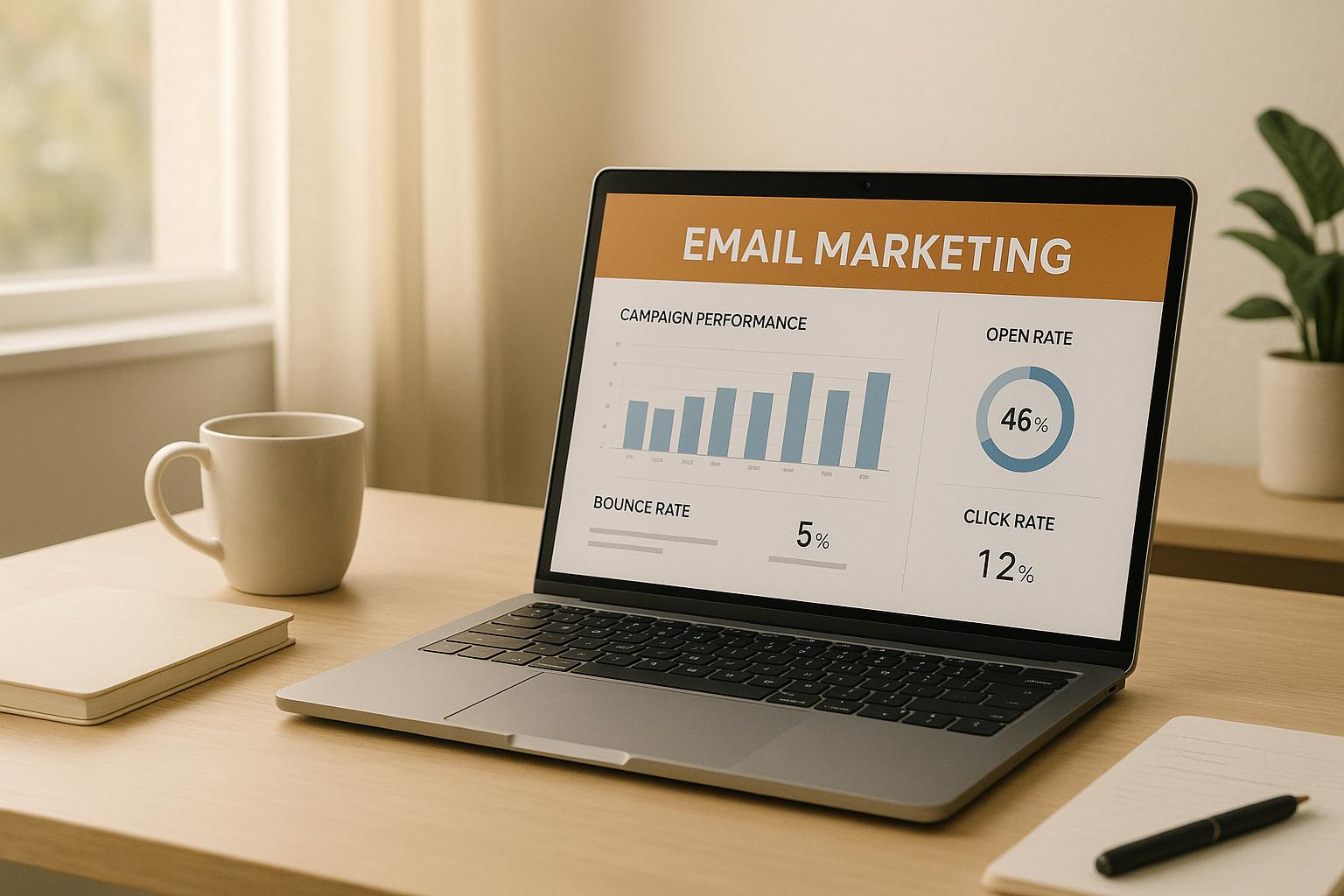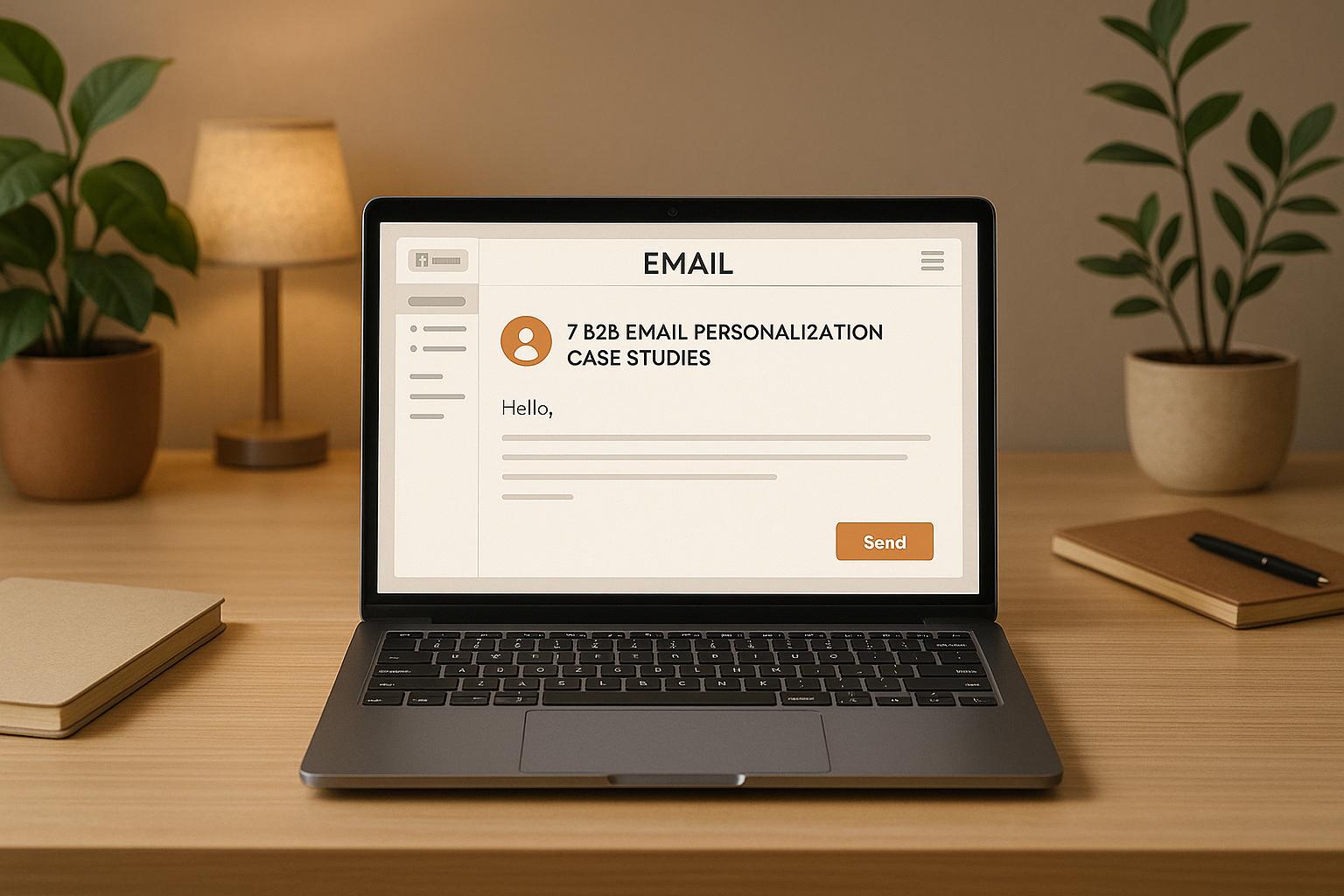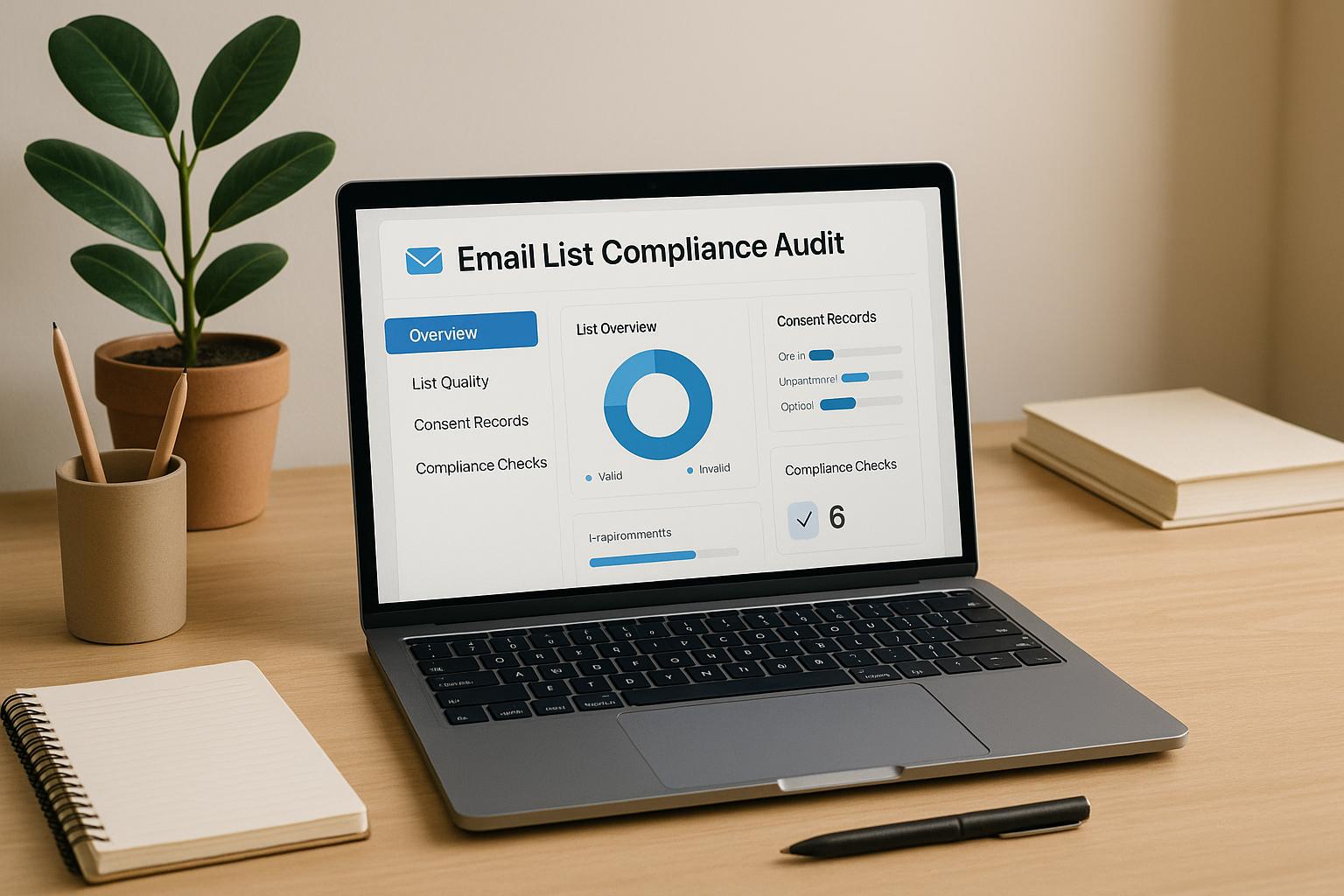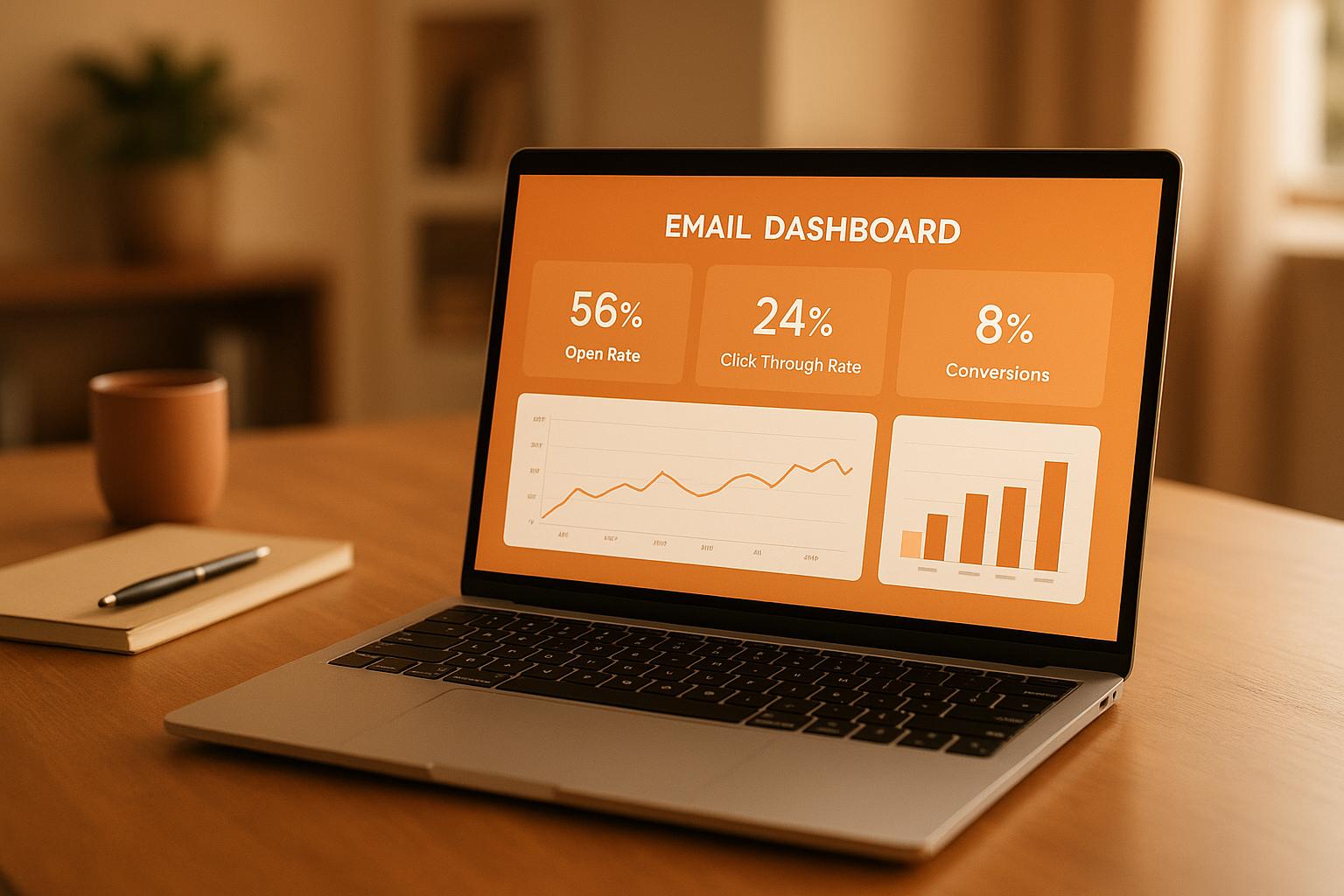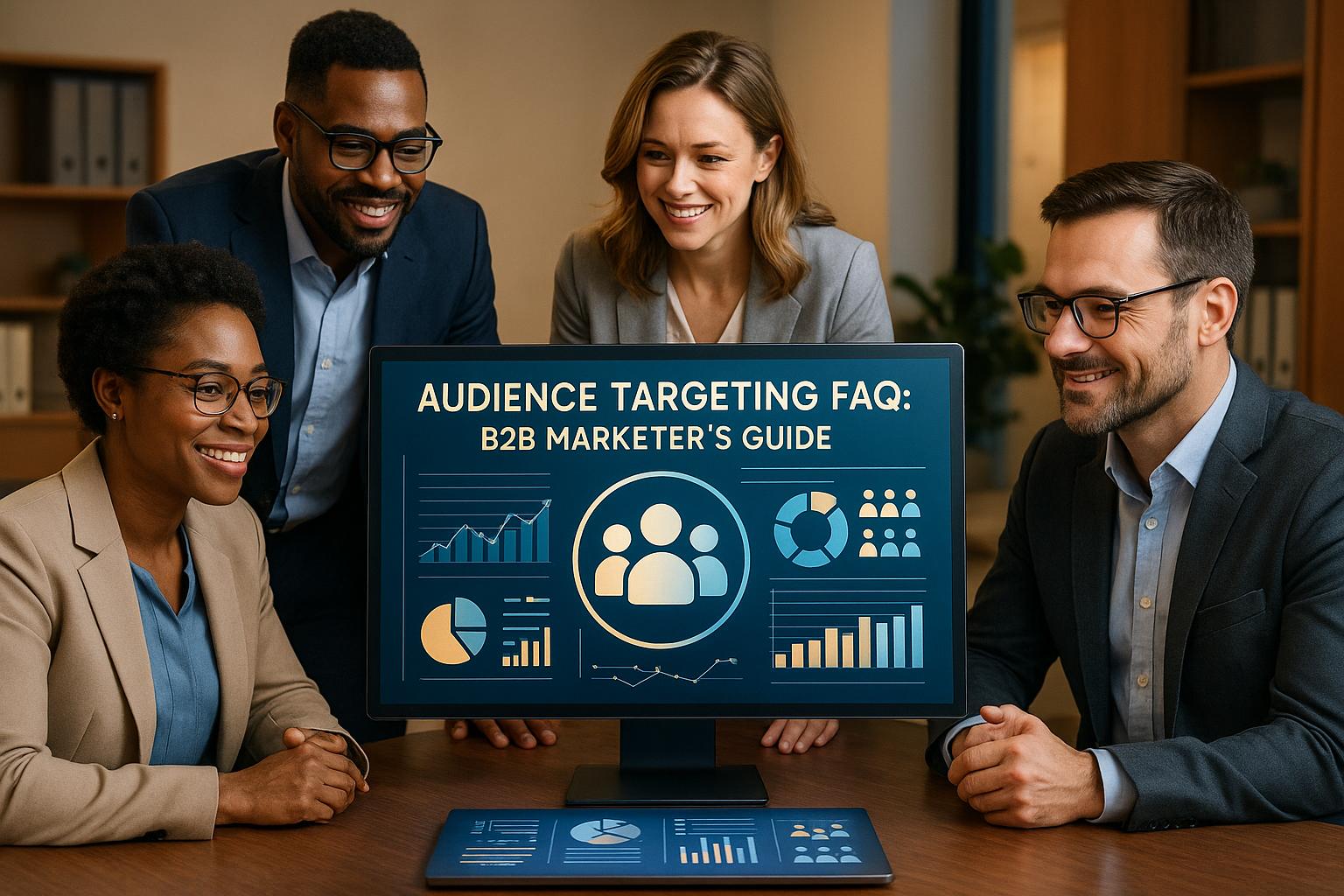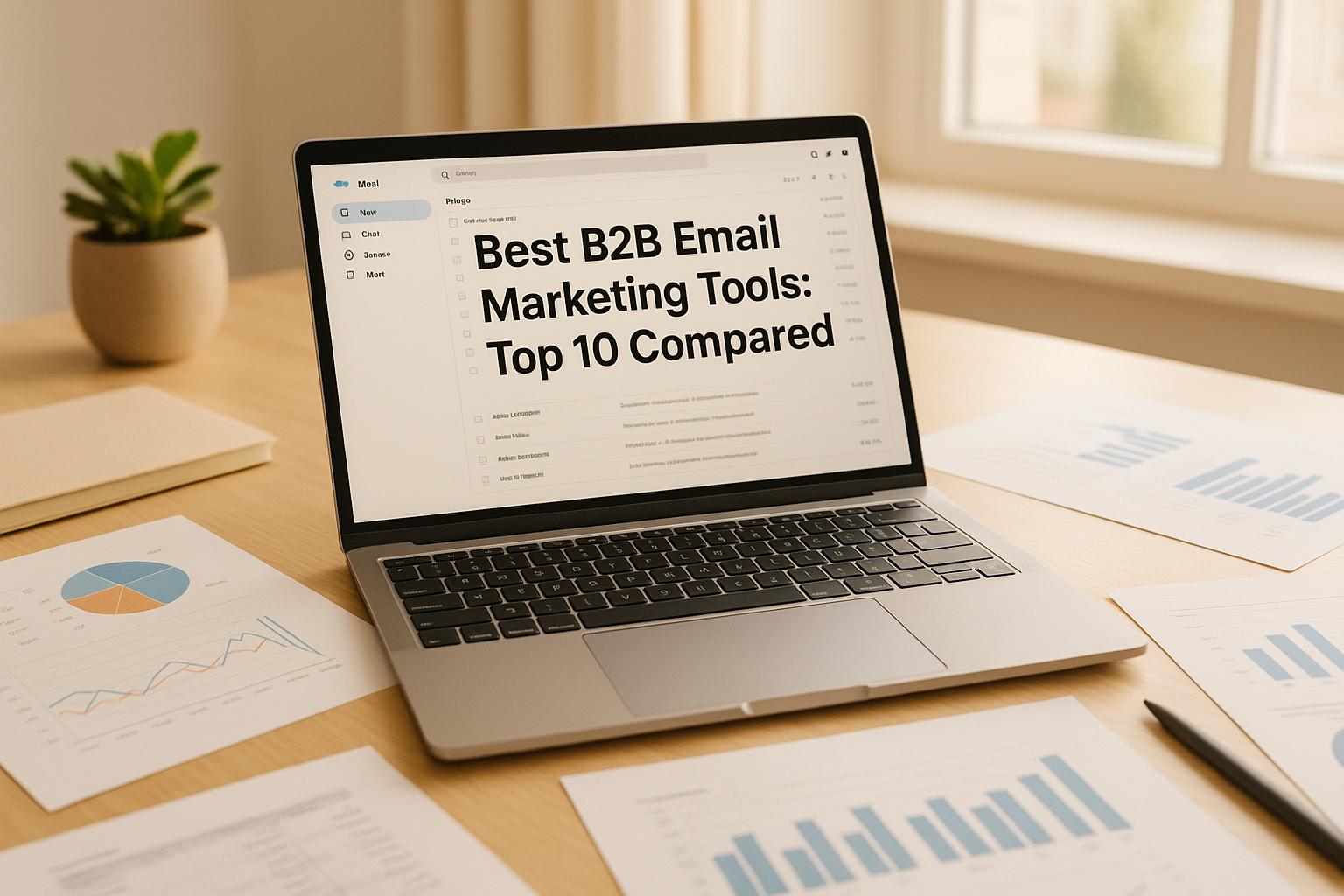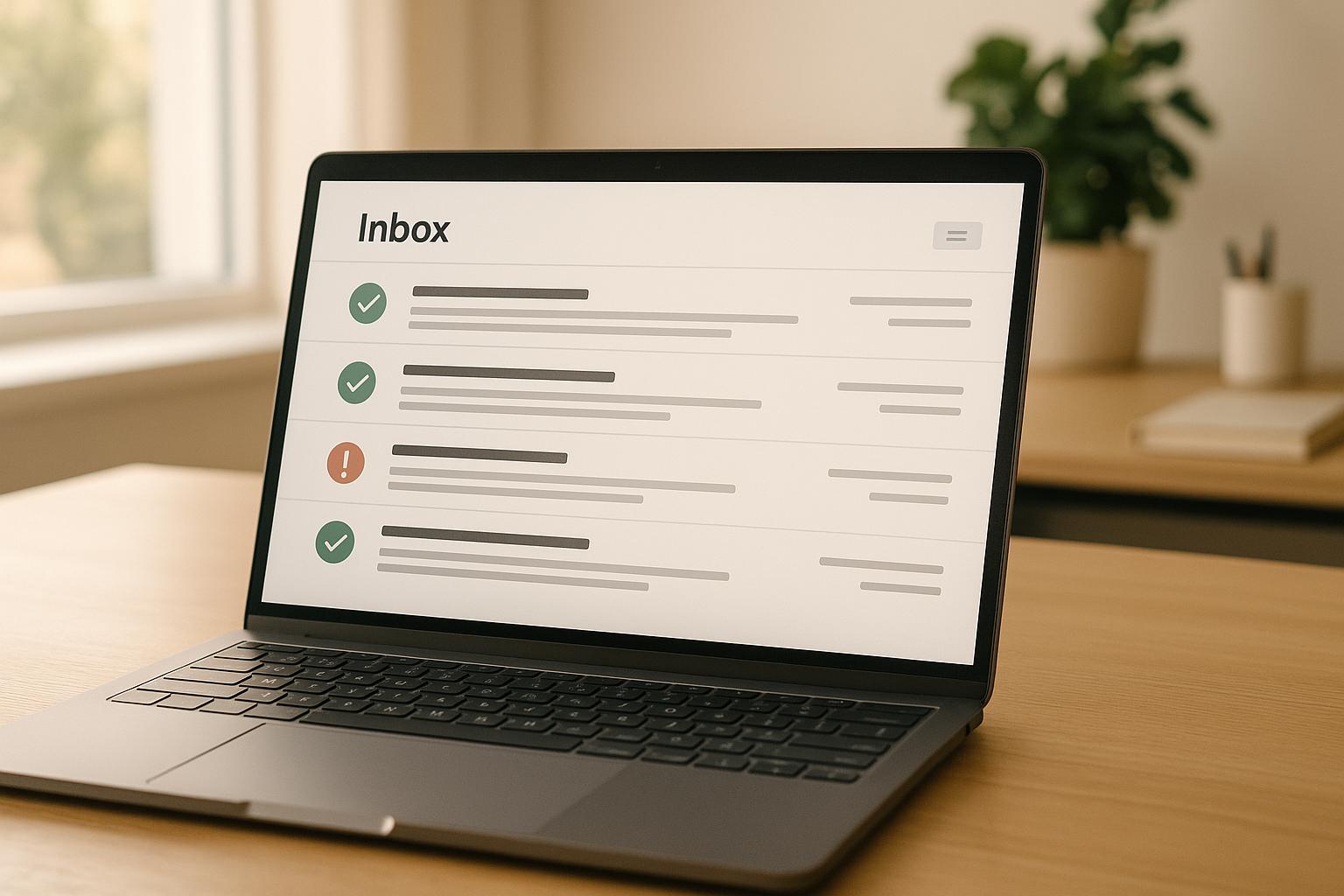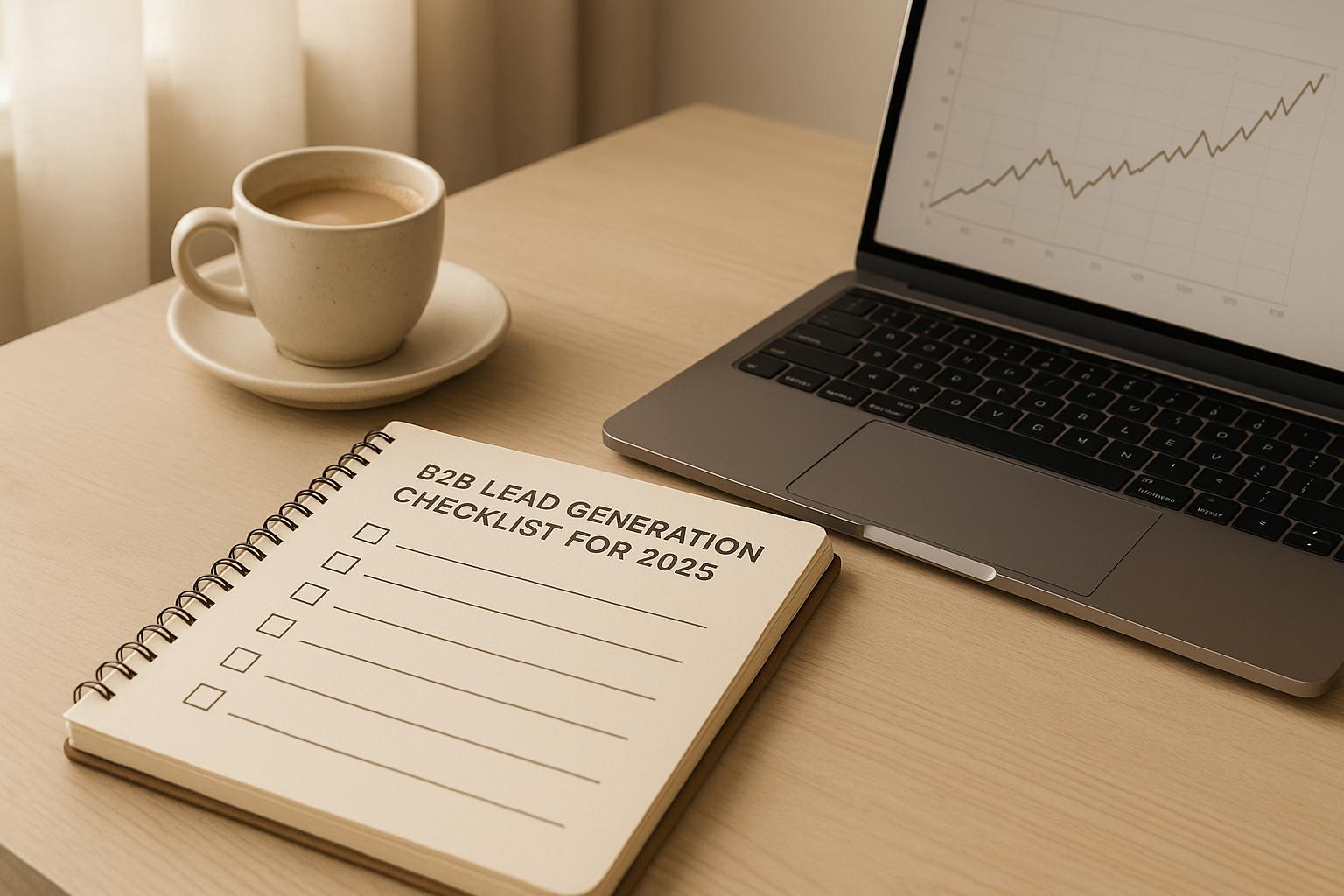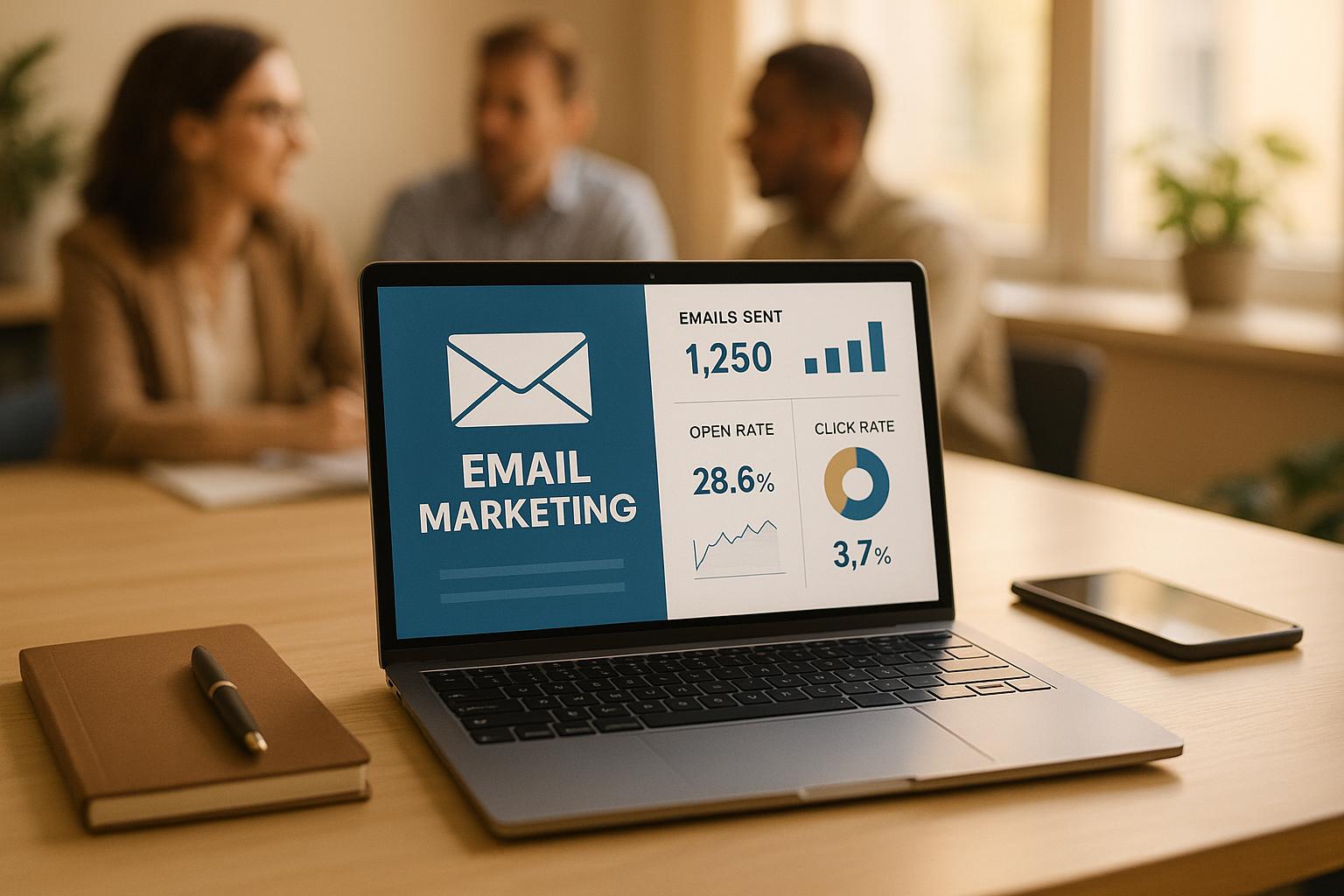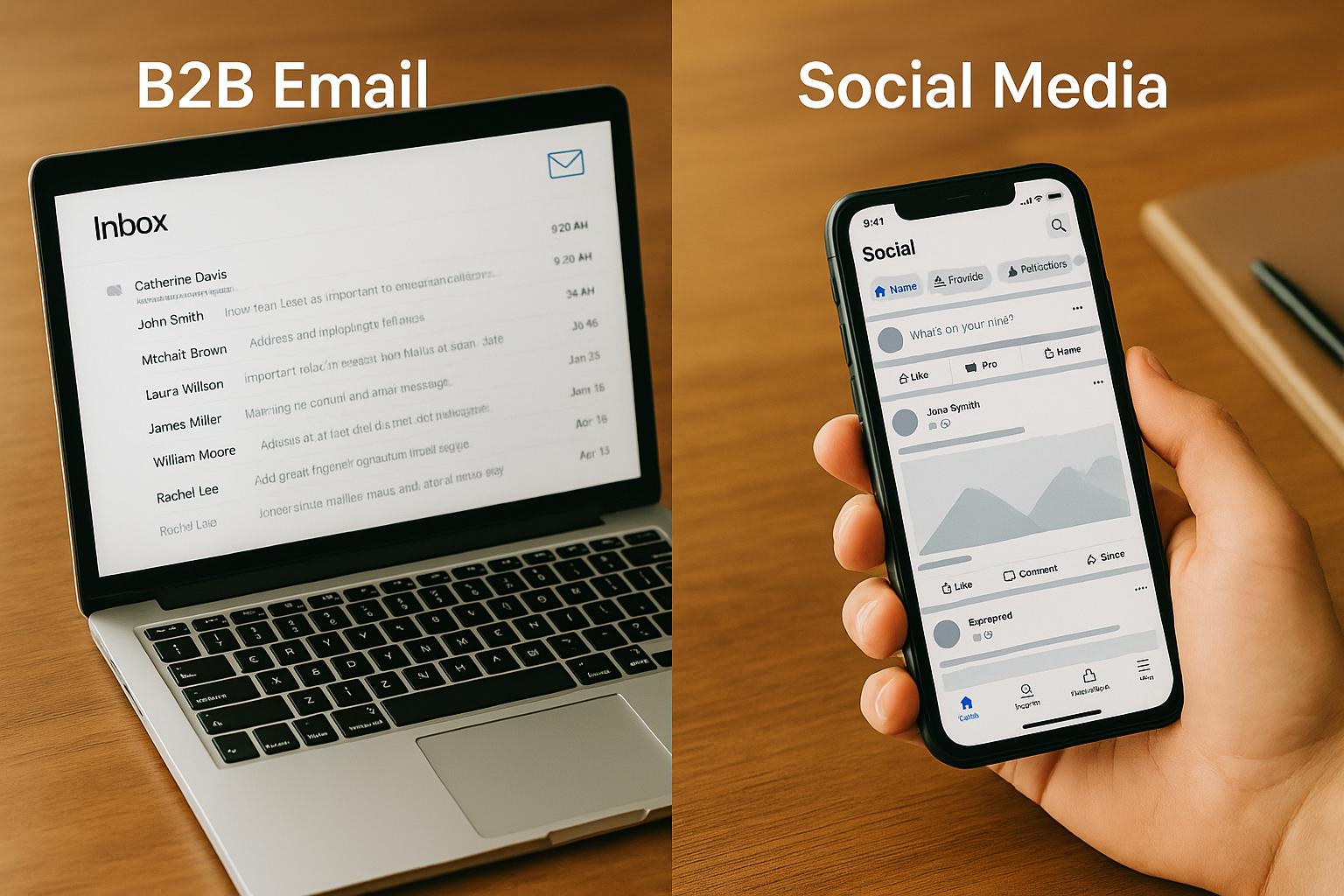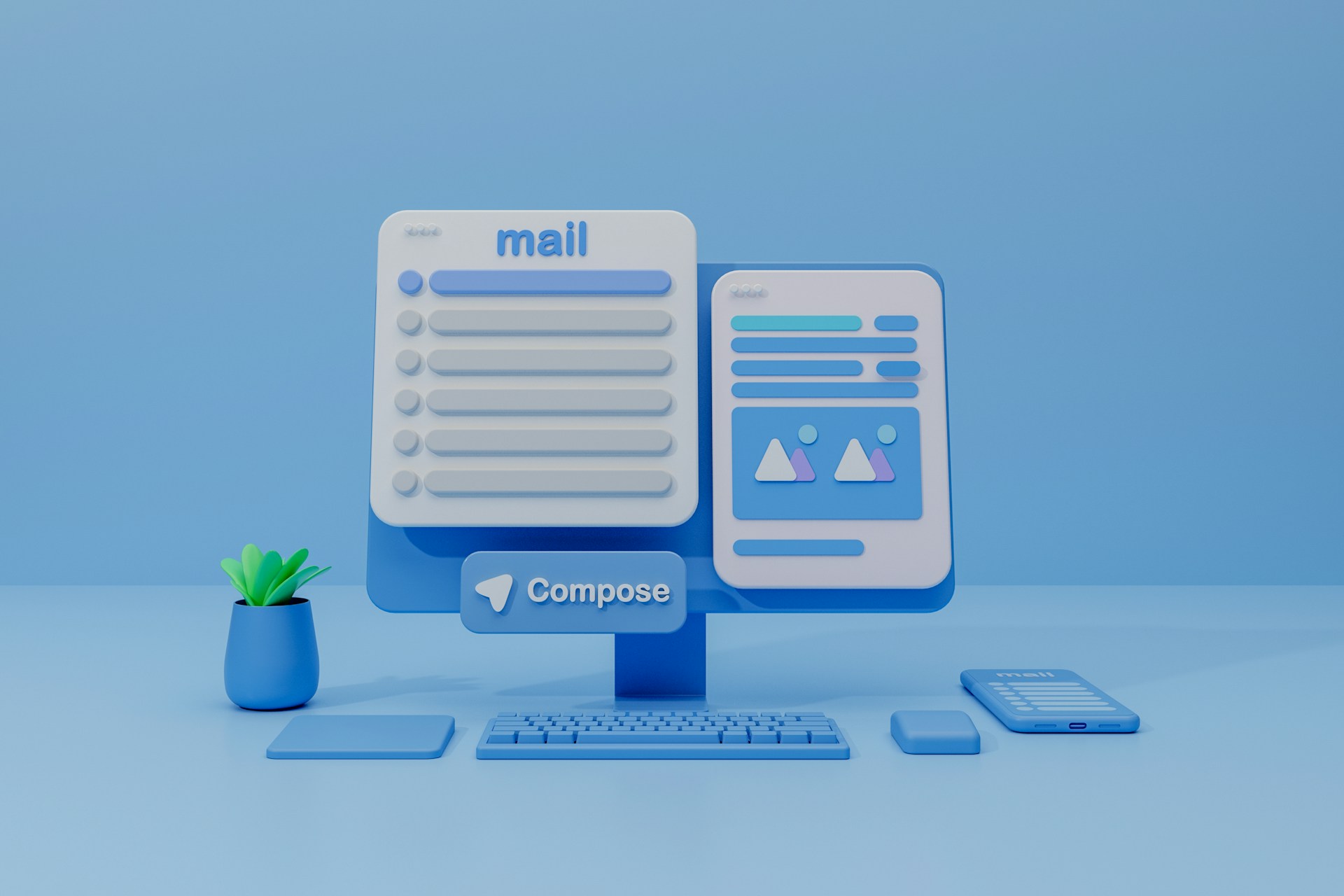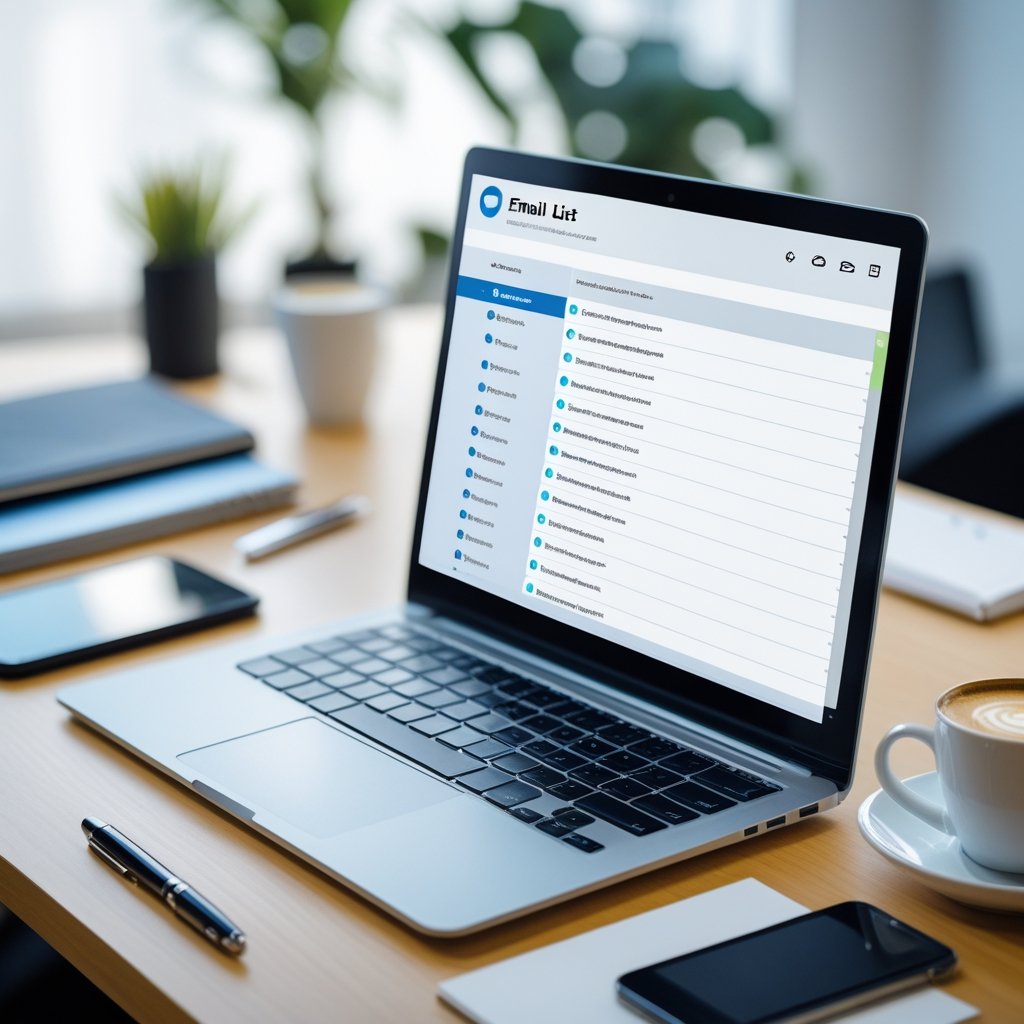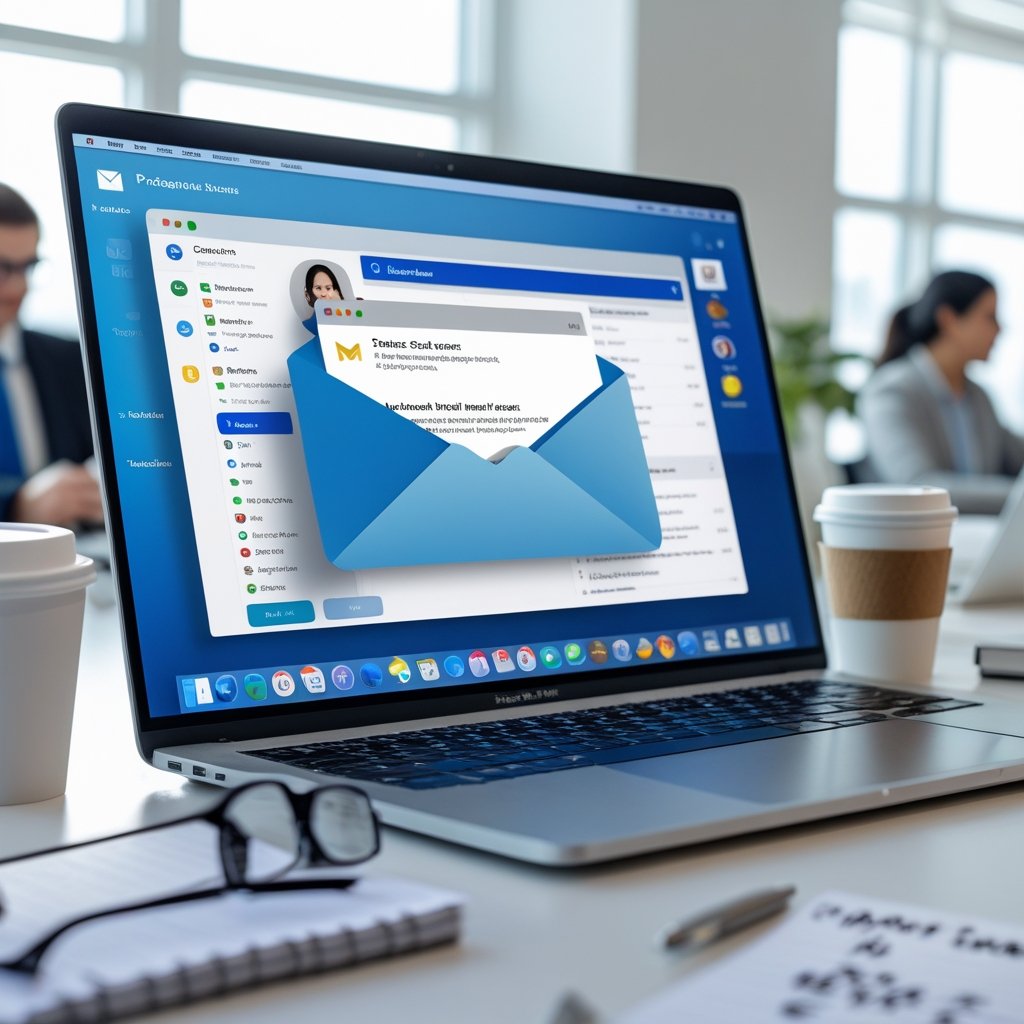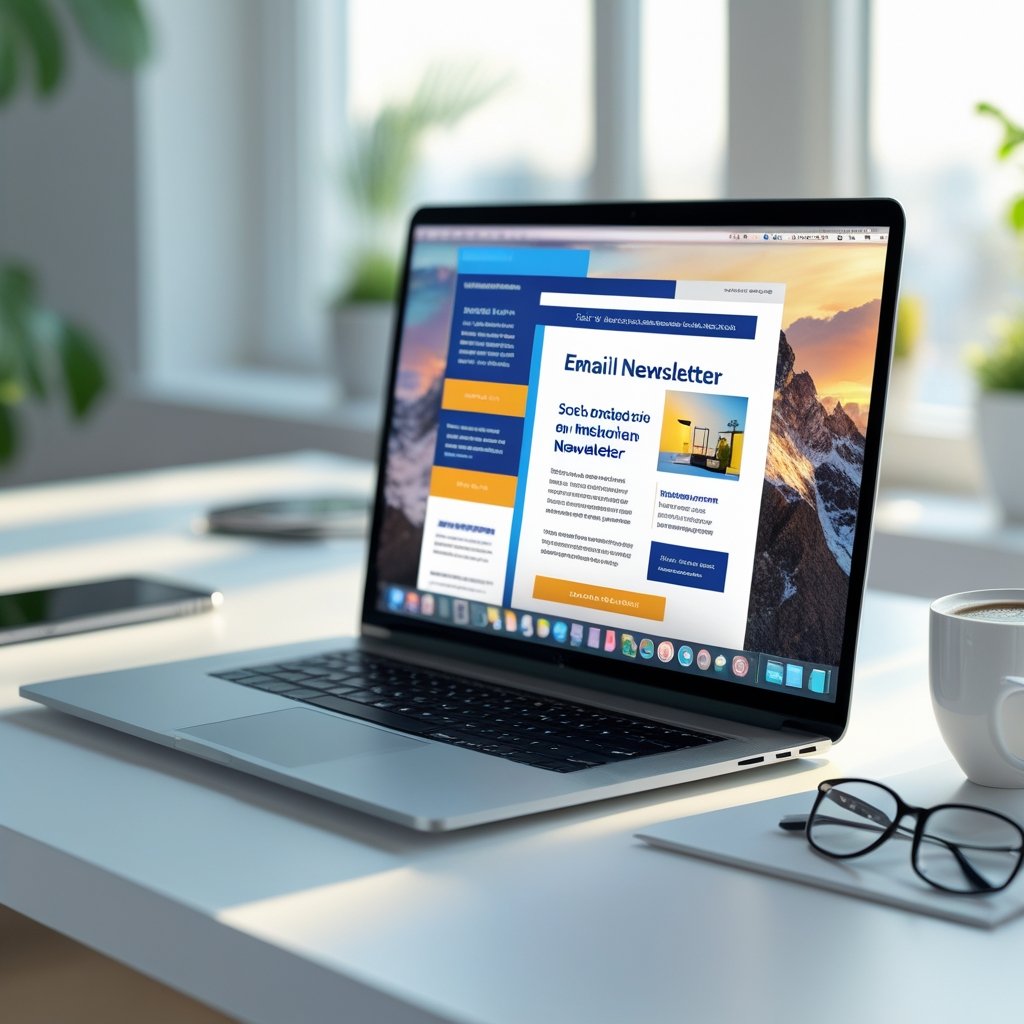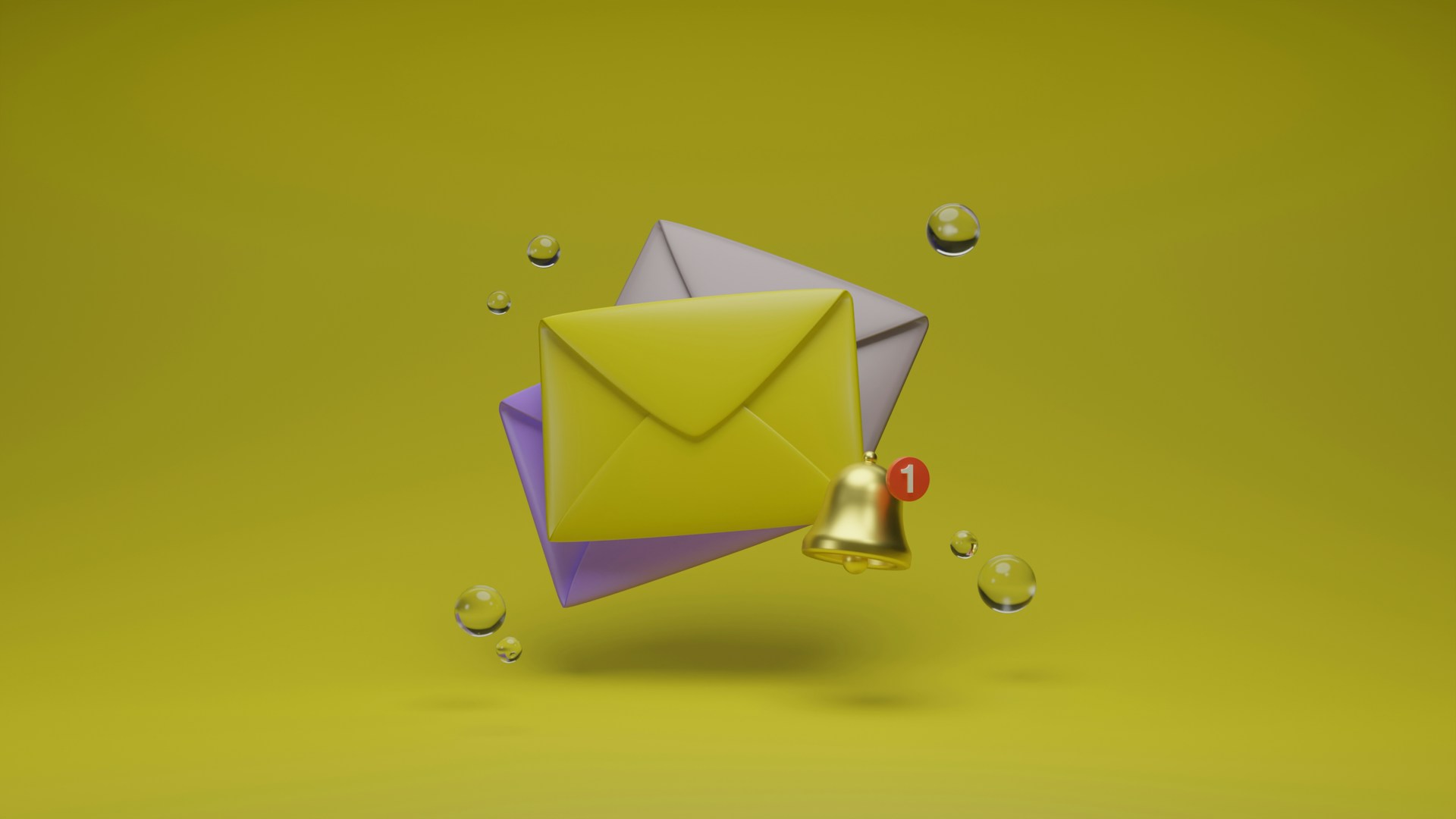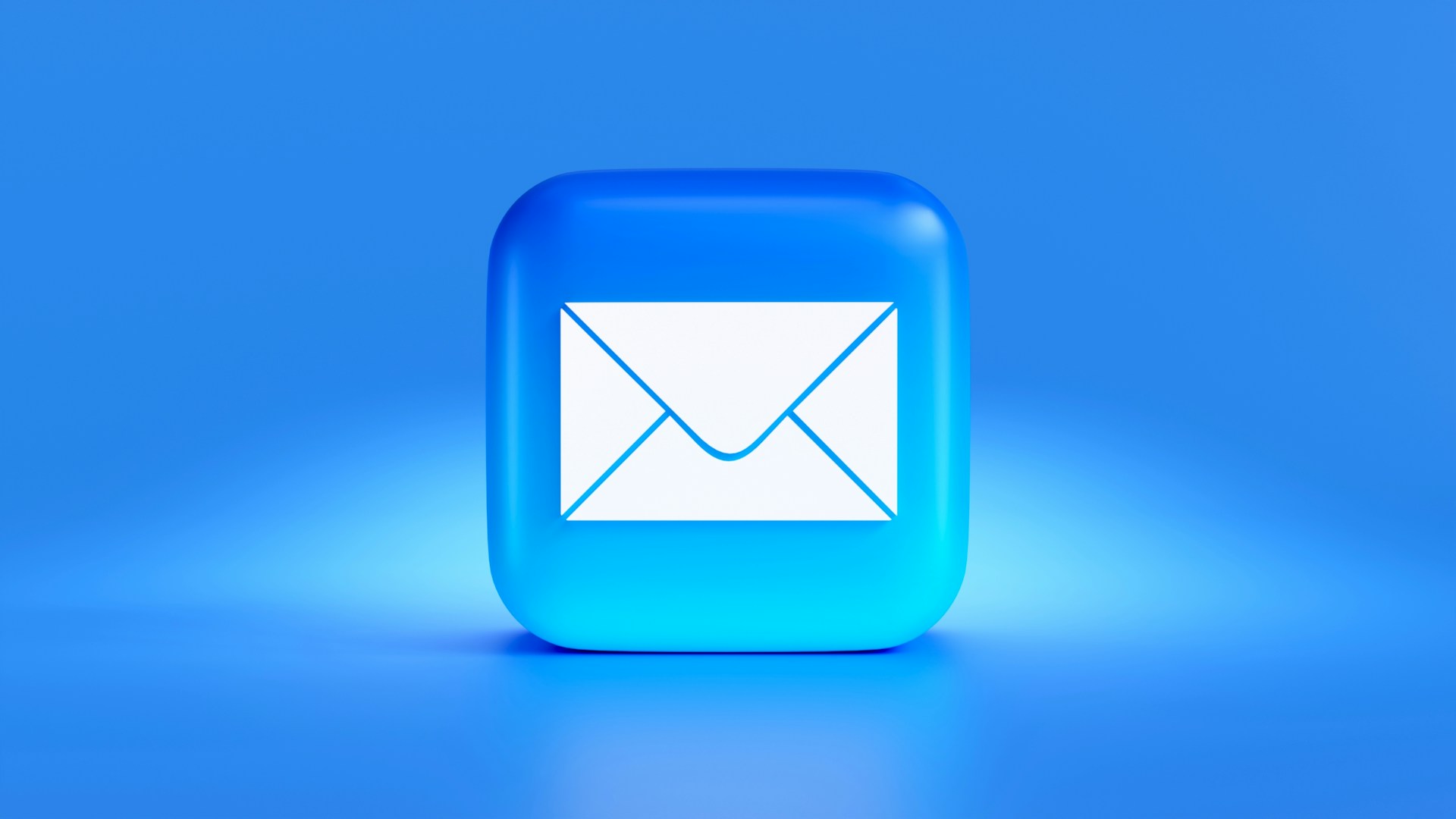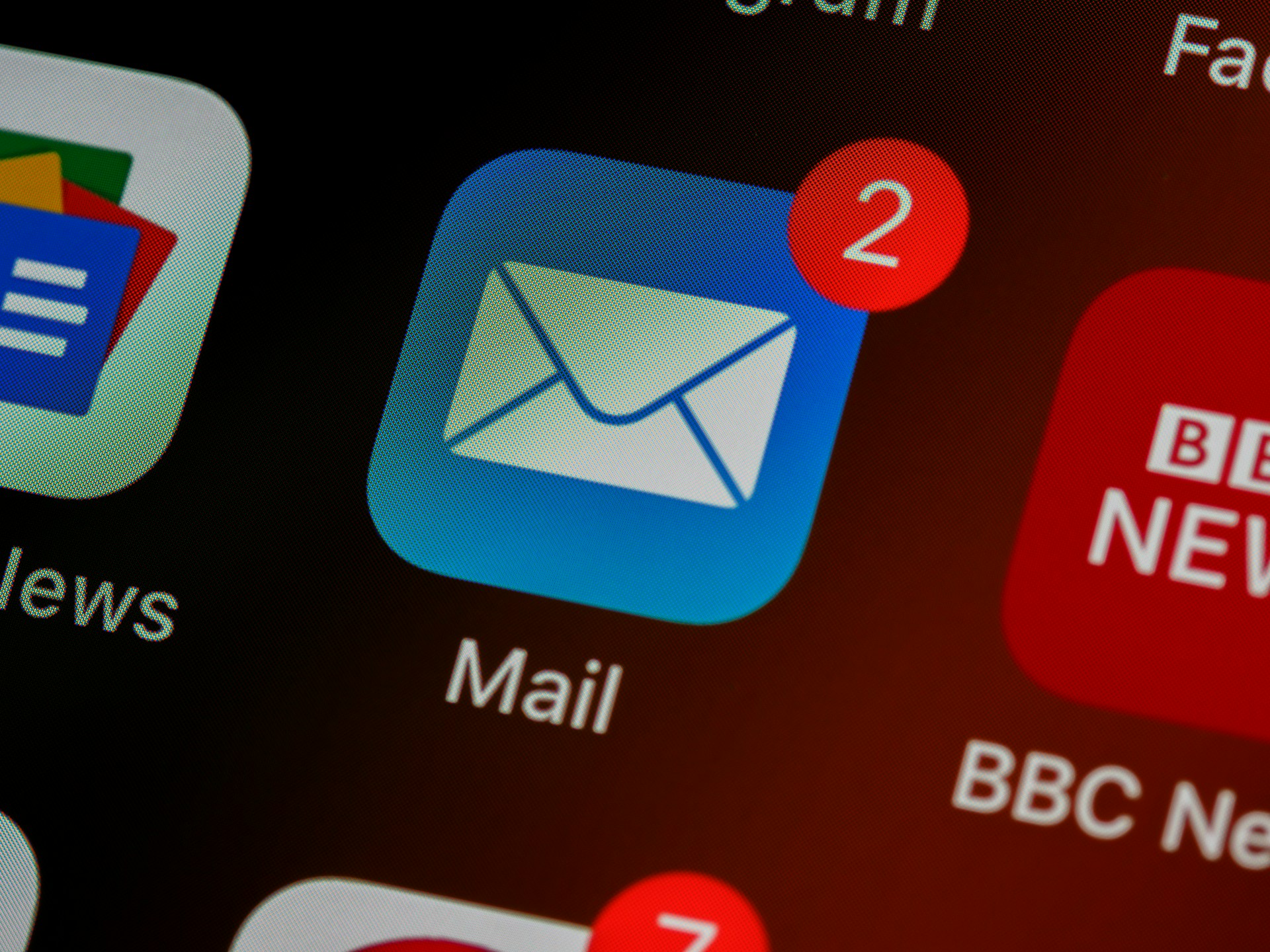How To Plan Newsletter Content Monthly
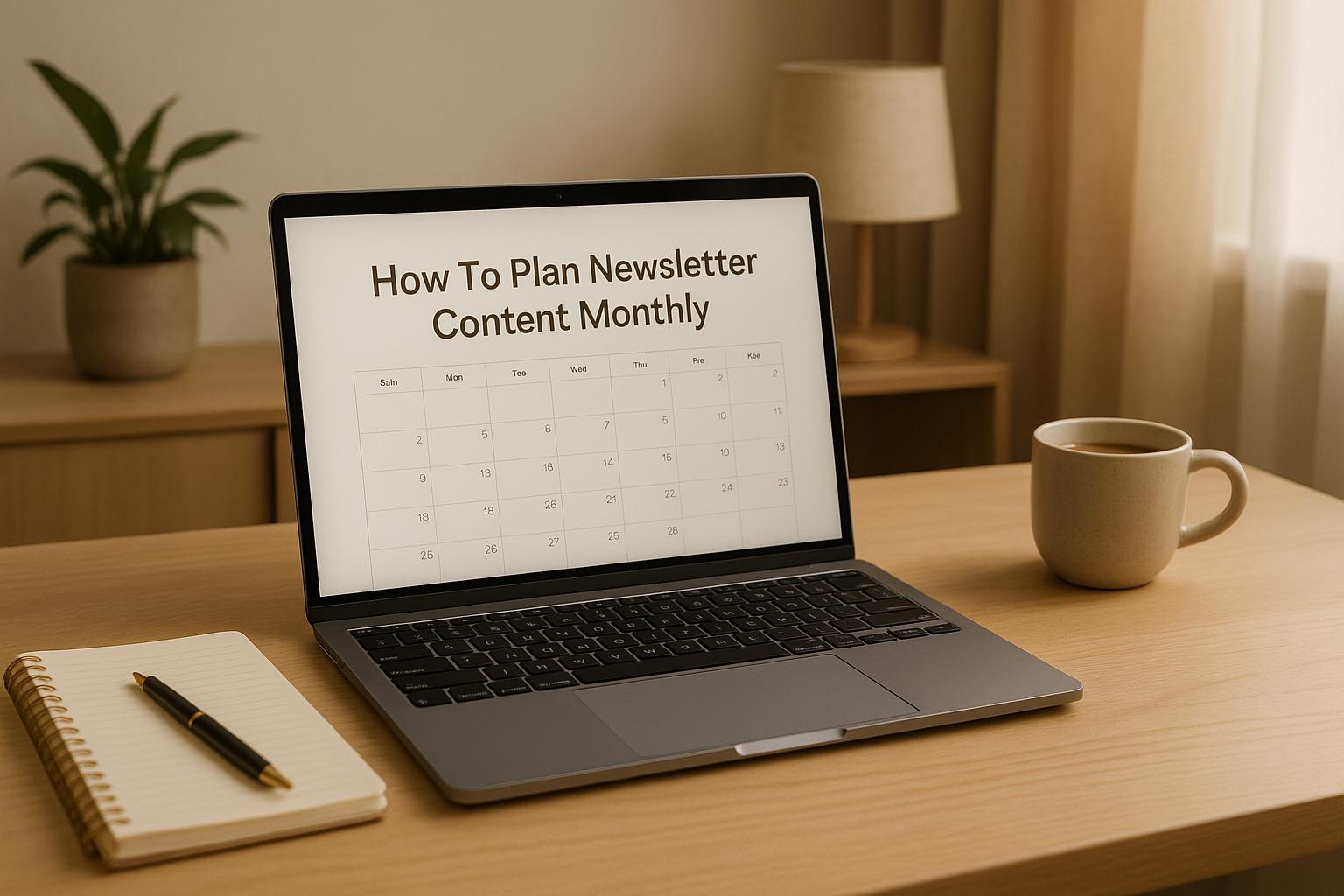
Planning your newsletter content monthly ensures your emails are purposeful, organized, and aligned with business goals. Here's how to get started:
- Set Goals: Align your newsletter with clear objectives, like lead generation, customer retention, or increasing engagement.
- Understand Your Audience: Use data and feedback to tailor content to their preferences and position in the buyer’s journey.
- Create an Editorial Calendar: Map out monthly themes, set deadlines, and assign roles to streamline production.
- Diversify Content: Mix educational, promotional, and interactive content to keep readers engaged.
- Use Tools and Analytics: Automate scheduling and track performance metrics to refine your strategy over time.
How to Make an Email Content Calendar + FREE Template
Step 1: Set Content Goals and Know Your Audience
To create a newsletter that delivers real results, start with a clear plan that ties your content to specific business goals. Without this foundation, your emails risk becoming a random assortment of updates that don’t truly engage your audience or drive outcomes.
The best B2B newsletters are built on two pillars: well-defined objectives and a deep understanding of the audience. With these in place, every piece of content you create will have purpose and direction, laying the groundwork for a solid content strategy.
Define Clear Newsletter Goals
Your newsletter goals should align with your broader marketing objectives. For example:
- If lead generation is your priority, focus on capturing contact information from prospects who interact with your content.
- For customer retention, use the newsletter to keep current clients informed with updates about your product and industry trends.
If you’re aiming for revenue growth, set specific financial targets. For instance, you might aim to generate $50,000 in sales each quarter through newsletter-driven webinars, product demos, or exclusive offers. Concrete goals like this give your team a clear benchmark to measure success.
You can also focus on engagement metrics. Instead of vague goals like “increase open rates,” go for something more specific, such as “achieve a 25% open rate among C-suite subscribers” or “drive 100 clicks per newsletter to our case studies.”
For brand awareness, the goal might be to establish thought leadership in your industry. Success here could be measured by social media shares, mentions in relevant publications, or invitations to speak at industry events - all sparked by your newsletter content.
Whatever your focus, make your goals measurable and time-bound. For example, rather than saying, “improve newsletter performance,” aim for something like “increase click-through rates by 15% in three months” or “generate 200 new marketing-qualified leads by year-end.”
Research Your Audience
Knowing your audience goes beyond just demographics. To truly connect, you need to understand their daily challenges, preferred communication styles, and the kind of content that influences their decisions.
Start by diving into subscriber data. Analyze which content gets the most clicks, when your emails are opened, and which subject lines perform best. These insights can reveal preferences that traditional surveys might miss.
To deepen your understanding, conduct customer interviews. Spend 15–20 minutes with subscribers from different groups to learn about their content preferences, pain points, and how they consume information during the workday.
Consider where your audience is in the buyer’s journey. New prospects may need educational content to build trust and showcase your expertise, while existing customers might prefer updates on product features, success stories, or advanced tips they can act on right away.
Industry-specific nuances are also critical. For instance, a newsletter for healthcare executives will require a different tone, depth, and compliance considerations than one aimed at startup founders. Think about factors like regulatory requirements, budget cycles, and decision-making processes when tailoring your content.
Leverage segmentation data to make your messaging even more relevant. Segment by company size, job role, location, or engagement history. For example, a small business owner might prefer quick, actionable advice, while a corporate executive may value in-depth industry analysis.
Set Your Brand Voice and Tone
Your newsletter’s voice and tone should reflect your company’s personality while aligning with what your audience expects. Consistency is key - it builds trust and helps readers recognize your brand across all communications.
For most B2B audiences, a professional yet approachable tone works well. You want to demonstrate expertise without sounding overly formal or bogged down by jargon.
The nature of your industry will influence your tone. A cybersecurity firm might opt for a serious, authoritative voice to match the critical nature of their work. On the other hand, a marketing software company might take a more conversational, creative approach to suit their audience.
Your company’s position in the market also plays a role. Established industry leaders can afford to take bold stances on hot topics, while newer companies may focus on being helpful and educational to build credibility.
Let your company values shine through in your voice. If innovation is central to your brand, highlight forward-thinking trends and ideas. If reliability is your strength, focus on proven strategies and long-term solutions.
Document your voice and tone guidelines for consistency. Include examples of phrases to use and avoid, preferred industry terminology, and tips for handling different types of content, from product updates to thought leadership articles.
Finally, don’t be afraid to test different approaches. Experiment with small audience segments and track engagement metrics to see what resonates. With clear goals, a deep understanding of your audience, and a consistent voice, you’ll be ready to craft an editorial calendar that works.
Step 2: Build a Monthly Editorial Calendar
Once you’ve nailed down your content goals and understand your audience, the next step is to create a monthly editorial calendar. This tool transforms those last-minute scrambles into a well-organized, purposeful plan that aligns with your business priorities and seasonal opportunities.
The secret to a great calendar is striking the right balance between structure and flexibility. It should provide enough guidance to keep your team on track while leaving room to adjust for unexpected industry developments or timely opportunities.
Choose Monthly Themes and Topics
Monthly themes give your newsletter a sense of continuity, keeping subscribers engaged and eager for the next issue. Instead of jumping from one random topic to another, a cohesive theme creates a narrative your audience can follow.
Start by aligning your themes with your business calendar and key industry events. Think about how these themes can support your sales cycle or match your audience’s seasonal needs. For example, tax software companies might focus on compliance updates in February and March, while event planners could highlight summer themes during the spring booking season.
Your product roadmap should also play a role. If you’re launching a new feature in March, consider dedicating February’s theme to the challenges that feature will address. This sets the stage for a smooth introduction.
Don’t forget about evergreen topics - those that stay relevant no matter the time of year. Themes like productivity hacks, leadership advice, or industry best practices can fill gaps in your calendar and consistently deliver value.
To stay ahead, build a theme bank with 15-20 ideas you can pull from anytime. This way, you’ll avoid scrambling for inspiration when deadlines loom.
Once you’ve chosen your themes, set clear deadlines to keep the production process running smoothly.
Set Deadlines and Milestones
Deadlines are your best friend when it comes to avoiding the chaos of last-minute work. They help ensure quality while keeping stress levels in check.
Start by working backward from your newsletter send date. For instance, if you send newsletters on the first Tuesday of every month, aim to finalize everything at least two days prior. This buffer gives you time to handle unexpected issues, like broken links or last-minute feedback.
Break the process into manageable steps:
- Set deadlines for content creation, keeping in mind the complexity of the material. A newsletter with original research or interviews will need more time than one curating existing blog posts.
- Include time for fact-checking, legal reviews (if needed), and sign-offs from subject matter experts.
- Schedule intermediate milestones like topic approval, first drafts, and design mockups. This helps you spot potential delays early and keeps the project on track.
Also, consider your team’s workload. If someone is juggling multiple priorities, like a product launch or event planning, adjust timelines to avoid burnout. The goal is to set realistic deadlines that maintain quality without overwhelming your team.
To stay organized, use a master timeline template to map out your monthly schedule.
Assign Team Roles and Tasks
Clear roles and responsibilities are crucial for a smooth workflow. When everyone knows what they’re accountable for, tasks are less likely to slip through the cracks.
Start by assigning a content lead who oversees the strategy and ensures quality. This person will make final decisions, resolve conflicts, and act as the main point of contact for stakeholders outside the team.
Your content creators - writers, designers, and analysts - will handle the heavy lifting. Writers focus on crafting the copy, designers ensure the visuals are on point, and analysts provide data insights to refine your approach.
It’s also helpful to have a project manager who keeps everyone on schedule and flags potential issues. For specialized content, involve subject matter experts from other departments. For example, your product team might contribute to feature announcements, while sales can share customer insights to guide the content direction. Be clear about their role - are they reviewing, providing input, or creating content?
Set up a review and approval process to avoid bottlenecks. Decide who has final sign-off and how to handle disagreements. This ensures decisions are made quickly and efficiently.
Finally, plan for the unexpected. If a key team member is unavailable, who steps in? Documenting backup plans for critical roles can save you from delays when someone is out sick or tied up with other projects.
A task ownership chart is a great way to visualize who’s responsible for each part of the newsletter. It helps prevent workload imbalances and keeps everyone on the same page.
Regular team check-ins - even a quick 15-minute meeting each week during production - can help catch small issues before they become big problems. These touchpoints keep everyone aligned and ensure the process stays on track.
Step 3: Select and Organize Your Newsletter Content
With your calendar in place, it’s time to carefully select and organize content that keeps readers engaged. A well-structured newsletter ensures every piece complements the others, creating a seamless experience that keeps your audience coming back for more.
Mix It Up with Different Content Types
A mix of content types can turn your newsletter into a must-read resource. People consume information differently, so offering a variety of formats ensures there’s something for everyone.
- Educational content should take center stage. Share industry insights, how-to guides, trend analyses, or expert opinions. These pieces build your brand’s authority while giving readers actionable tips they can use right away.
- Promotional content has its place too - just be mindful of balance. Highlight updates about your products or services, share case studies, or announce upcoming events. Always frame these in terms of how they benefit your readers, rather than focusing solely on your business.
- Engagement-driven content helps connect on a personal level. Consider including community spotlights, behind-the-scenes looks, polls, or questions that invite interaction. This type of content can make your brand feel more approachable and relatable.
To streamline your process, consider creating recurring content categories. For instance, you could include a monthly industry trend analysis, a customer success story, a quick tip, and a thought leadership piece. This ensures most of your newsletter focuses on reader value, while leaving some space for company updates.
Once you’ve curated your content, it’s time to make sure it’s easy to digest.
Make It Reader-Friendly
Your readers are busy, so clarity and scannability are key. A well-organized layout can make all the difference between a newsletter that gets read and one that’s ignored.
- Headlines and subheadings should guide readers through your content. Use benefit-driven titles that clearly state what they’ll gain. For example, instead of “Q3 Updates,” try something like “3 New Features That Save You Time.”
- Short paragraphs are easier on the eyes. Stick to 2–3 sentences per paragraph and use white space to create a clean, inviting layout for both desktop and mobile readers.
- Visual hierarchy helps readers navigate effortlessly. Use bold text for key points, italics for emphasis, and bullet points for lists. Highlight important sections with callout boxes or dividers for added clarity.
- Strategic visuals can enhance your message. Charts, graphs, and infographics make complex data easier to grasp, while relevant images add visual interest. Just make sure every visual serves a purpose.
For longer newsletters, use headers or dividers to clearly separate sections. This lets readers jump straight to what interests them. And don’t forget the inverted pyramid approach - lead with the most important information, followed by supporting details. That way, even skimmers walk away with the key takeaways.
Let Stories Do the Talking
Adding stories to your newsletter can transform straightforward information into content that resonates. Stories engage readers on a deeper level, helping them connect emotionally while gaining practical insights.
- Customer stories are especially powerful in B2B newsletters. Instead of saying your product improves efficiency, share a real customer’s journey. Explain their challenges, how your solution helped, and the results they achieved.
- Behind-the-scenes narratives give readers a peek into your company’s culture and processes. Share how your team solved a tricky problem or learned from a mistake. These stories humanize your brand and build trust.
- Industry case studies showcase your expertise while offering valuable lessons. Walk through real-world scenarios, highlight decisions made, and share actionable takeaways.
- Personal anecdotes from leadership or team members can illustrate broader concepts. For example, a CEO might share a story about navigating a tough client relationship to introduce a discussion on effective communication.
When crafting stories, set the stage with context, outline the challenge, and finish with the resolution. Even a brief anecdote can make abstract ideas feel relatable, leaving readers with both emotional connections and useful insights.
sbb-itb-8889418
Step 4: Use Tools for Automation and Analytics
Once your content is organized, it's time to bring in automation and analytics tools to make your newsletter planning more efficient and impactful. The right tools not only simplify your workflow but also provide valuable insights to help you create content that connects with your audience.
Automate Content Scheduling and Delivery
Automation takes the hassle out of remembering send dates and ensures your newsletters consistently land in your subscribers' inboxes. With scheduling tools, you can plan and prepare your content weeks in advance, setting specific delivery times to reach your audience when they’re most likely to engage. This approach lets you batch-create newsletters during your most productive moments and focus on other priorities.
But automation doesn’t stop at scheduling. Advanced platforms can segment your audience automatically based on their behavior, demographics, or engagement history. This means you can send tailored content to different subscriber groups without juggling multiple lists manually.
For example, Breaker simplifies lead generation by identifying and attracting subscribers who are genuinely interested in your content. Instead of spending hours building subscriber lists manually, Breaker ensures you're targeting the right audience, helping your newsletters reach the people who matter most.
Reusable templates are another time-saver. They help you maintain a consistent look and feel across different types of newsletters - whether you’re sharing a monthly industry update, product news, or an educational series.
Once these systems are in place, they handle repetitive tasks for you, freeing up your time to focus on crafting high-quality content and refining your strategy.
Track Performance with Analytics
Data is your best friend when it comes to understanding what works and what doesn’t. Analytics give you a clear picture of how your audience interacts with your newsletters, helping you make informed decisions for future content.
Key metrics like open rates, click-through rates, and conversions can reveal what resonates with your audience. For example, tracking link clicks can show which topics spark the most interest and which ones might need a different approach.
Conversion tracking is especially valuable because it ties newsletter performance to real business outcomes. Whether your goal is to drive demo requests, content downloads, or sales, this metric helps you see the tangible impact of your efforts. Sometimes, a newsletter with lower open rates might actually generate higher conversions, highlighting a highly engaged segment of your audience.
Platforms like Breaker make performance tracking straightforward, offering real-time insights into subscriber behavior. This detailed data doesn’t just tell you what happened - it helps you understand why it happened, giving you the tools to refine your strategy.
Over time, analyzing engagement patterns can also help you pinpoint the best days and times to send your newsletters. While general guidelines are helpful, your own data may reveal unique trends specific to your audience. Use these insights to fine-tune your approach and maximize engagement.
Improve Based on Data
The best newsletters are the result of constant tweaking and learning. By analyzing subscriber behavior, you can turn good content into great content.
Start by identifying your top-performing newsletters. Look for patterns in subject lines, content formats, visuals, or topics that consistently perform well. For instance, if newsletters featuring customer success stories get more engagement than product-focused ones, consider adjusting your content mix to include more storytelling.
Refine your strategy by aligning your subject lines, send times, and audience segmentation with the data. You might discover that newer subscribers prefer shorter, more direct content, while long-term readers engage more with in-depth pieces. Or, you might find that certain segments respond better to specific themes or formats. Use these insights to create more targeted content plans for the months ahead.
The goal isn’t to get everything perfect right away - it’s about evolving your strategy based on real-world results. Let each month’s performance guide your next steps, creating a cycle of improvement that benefits both your audience and your business.
Step 5: Review and Improve Your Strategy
A great newsletter strategy isn’t static - it evolves to meet audience expectations and keep up with market shifts. By refining your approach based on data and feedback, you can ensure your monthly plan stays flexible and aligned with your goals. Regular reviews help you identify areas for improvement, seize new opportunities, and keep your content engaging.
Review Monthly Performance
At the end of each month, dive into your newsletter's performance. Don’t just skim the open rates - dig deeper to understand how your content truly resonated and why.
Start by comparing key metrics like open rates, click-through rates, unsubscribe rates, and conversion data to previous months. Look for trends or anomalies. For instance, a dip in open rates but a boost in click-through rates might suggest your subject lines need tweaking, even though your content is on point.
Take a closer look at how individual newsletters performed. Your top-performing piece might highlight a format or topic that your audience loves, while the lowest-performing one can guide you on what to avoid or improve. Subscriber feedback - through comments, replies, or even social media mentions - provides direct insight into what’s working and what isn’t. Don’t shy away from negative feedback; it’s a goldmine for understanding where you can do better.
Also, evaluate your production process. Were there weeks when deadlines felt impossible to meet? Did certain types of content take longer to produce than expected? These insights can help you plan more effectively for the months ahead.
Use all this information to adjust your approach, ensuring your strategy stays relevant and effective.
Adjust to Audience and Market Changes
With performance insights in hand, fine-tune your strategy to reflect changing audience preferences and market conditions. What worked a few months ago might not hit the mark today, especially in industries that evolve quickly.
Keep an eye on industry trends and seasonal shifts. For example, if your audience is in the tech world, they might suddenly show more interest in AI advancements than in traditional software updates. Stay informed by following industry publications, social media conversations, and major events or conferences.
As your subscriber base grows, you might notice shifts in what different segments of your audience want. New subscribers may have different interests compared to your long-time readers. This doesn’t mean abandoning your core focus, but you might need to diversify your content or create specialized tracks.
Pay attention to what competitors are doing. If other newsletters in your niche start covering topics you’ve overlooked, consider expanding your scope. On the flip side, if everyone else is focusing on the same themes, explore areas that are being ignored.
Finally, keep up with changes in technology and platforms. New features in your newsletter tools might allow for better personalization or introduce creative content formats. Experiment with these updates to see how they can enhance your newsletter.
Update Your Editorial Calendar
Your editorial calendar should be a living document that adapts to the insights you gather and the trends you observe. Regular updates ensure your content stays relevant and aligned with your audience’s needs.
Replace underperforming themes with topics that spark more interest. For instance, you might find your readers prefer actionable how-to guides over industry updates - or vice versa. If your newsletter format feels stale, experiment with fresh approaches like adding visuals, featuring user-generated content, or inviting guest contributors. Test these changes gradually to see what sticks.
Timing matters, too. Your monthly review might reveal that certain days or times lead to better engagement. Adjust your schedule accordingly to maximize impact.
Reallocate resources based on what’s working. If a particular type of content consistently performs well but requires more effort, it might be worth dedicating additional time and resources to it. Conversely, scale back on content that doesn’t deliver strong results.
Look for ways to improve collaboration within your team. Maybe one team member excels at a specific type of content, or perhaps your review process could be more efficient. Reflect these insights in your calendar to streamline operations.
Don’t forget to plan ahead for important events, product launches, or seasonal opportunities. Add these to your calendar early so you can create content that supports them effectively.
When updating your calendar, take a measured approach. Avoid making drastic changes all at once, as this can confuse your audience and make it harder to track the impact of individual adjustments. Instead, implement changes step by step and allow time to evaluate their effectiveness before introducing further tweaks.
Conclusion: Main Points for Monthly Newsletter Planning
Planning your newsletter content on a monthly basis transforms ideas into actionable steps that produce measurable results. The five-step method we've discussed - setting clear goals, creating editorial calendars, organizing content effectively, using automation tools, and committing to continuous improvement - lays the groundwork for consistent newsletter success. Each step builds on the others to establish a reliable and strategic process.
Why Planning Matters
A structured plan directly impacts your success. Aligning your content with your business goals ensures that every newsletter contributes to engagement and growth. An editorial calendar becomes more than just a scheduling tool - it acts as a strategic guide for fostering stronger connections with your audience.
Monthly planning helps eliminate last-minute scrambles and keeps your team focused, improving both workflow and content quality. When everyone understands their roles and deadlines, the entire process runs more smoothly. Subscribers notice this consistency, which can lead to higher open rates and stronger engagement.
This proactive approach elevates your newsletter from being just another email in someone’s inbox to becoming a trusted resource. Instead of reacting to whatever feels urgent, you can deliberately address your audience’s challenges and guide them through their journey with your brand.
For B2B marketers using tools like Breaker, this planning framework enhances the platform's automated lead generation and targeting features. By aligning your content strategy with specific audience segments, you’re more likely to attract subscribers who are the right fit and ready to convert into customers.
Keep Improving Your Approach
While these benefits are substantial, newsletter success is an ongoing process. A monthly review cycle ensures your strategy stays relevant as your audience’s needs and market trends evolve. By analyzing each month’s performance, you can refine your approach and make your content even more impactful over time.
If the idea of monthly planning feels daunting, start small. Focus on one or two elements from this guide and implement them consistently before expanding your efforts. The goal is to build habits that your team can sustain over the long haul.
Always remember that your newsletter exists to serve your audience first. When you deliver thoughtful, well-planned content that addresses their needs, the business results will follow naturally. Subscribers can tell the difference between rushed emails and newsletters that are carefully crafted with their interests in mind.
Go beyond just tracking open rates. Evaluate how your planning process improves team efficiency, content quality, and subscriber satisfaction. These qualitative gains often have a greater impact on long-term growth than vanity metrics.
A systematic approach may take time to develop, but the payoff is worth it.
FAQs
What’s the best way to balance educational, promotional, and engaging content in my newsletter?
To craft a newsletter that truly resonates, aim for a balance in your content. A 90/10 approach works well: dedicate 90% of your newsletter to educational, informative, or community-related content, while reserving just 10% for promotional material. Depending on your audience, you might also consider an 80/20 split, with 80% focused on value-driven content and 20% on promotions.
Mix up the format to keep things interesting. Include videos, Q&A sections, or interactive features to maintain reader engagement. Prioritize delivering useful insights and information first, so any promotional content feels like a natural extension rather than an interruption.
What are some common challenges of creating a monthly newsletter plan, and how can you address them?
Creating a monthly newsletter plan isn’t always smooth sailing. You might run into hurdles like keeping everything organized, striking the right balance between too much or too little content, and staying flexible enough to adjust based on what your audience wants. But don’t worry - these challenges can be tackled with a bit of planning and teamwork.
Start by defining your goals clearly. What do you want your newsletter to achieve? Next, bring in key team members early in the process to brainstorm ideas and share the workload. Tools like templates or spreadsheets can also make things easier by keeping everything structured and easy to manage.
Make sure your content serves a dual purpose: it should align with your marketing goals while also addressing what your audience finds valuable or interesting. And don’t forget to check your performance data regularly. This will help you fine-tune your strategy, ensuring your newsletters stay relevant and achieve the impact you’re aiming for.
What’s the best time to send a newsletter to boost engagement?
The ideal time to send a newsletter in the US is usually mid-morning on weekdays, specifically between 9 AM and 12 PM. Among these, Tuesday, Wednesday, and Thursday tend to yield the best engagement. During this window, people are more likely to be checking their emails, which can result in higher open and click-through rates.
For the best chance of success, try scheduling your newsletter around 10 AM, a time when many are actively sorting through their inboxes. That said, it’s always a good idea to experiment with different times to discover what resonates most with your audience and aligns with your industry trends.



